X Shore Eelex 8000
Access BoatTEST's Tutorials on Electric Boats, Motors, and Accessories
Brief Summary
The X Shore Eelex 8000 is one of the first all-electric boats that has been accepted and sold widely around the world. It has been in full production for several years and has been designed for both fresh and saltwater applications. Its electric motor and twin lithium-ion batteries are from quality names in their respective fields. The boat has been in actual production since 2021.
Mission
The mission of X Shore is to lead the boating industry into the new world of sustainability. By reducing boat emissions to zero, as well as eliminating engine noise, the X Shore Eelex 8000 is setting a high bar for other vessels in class, because she is a day cruiser intended for a variety of applications and conditions in fresh and saltwater.
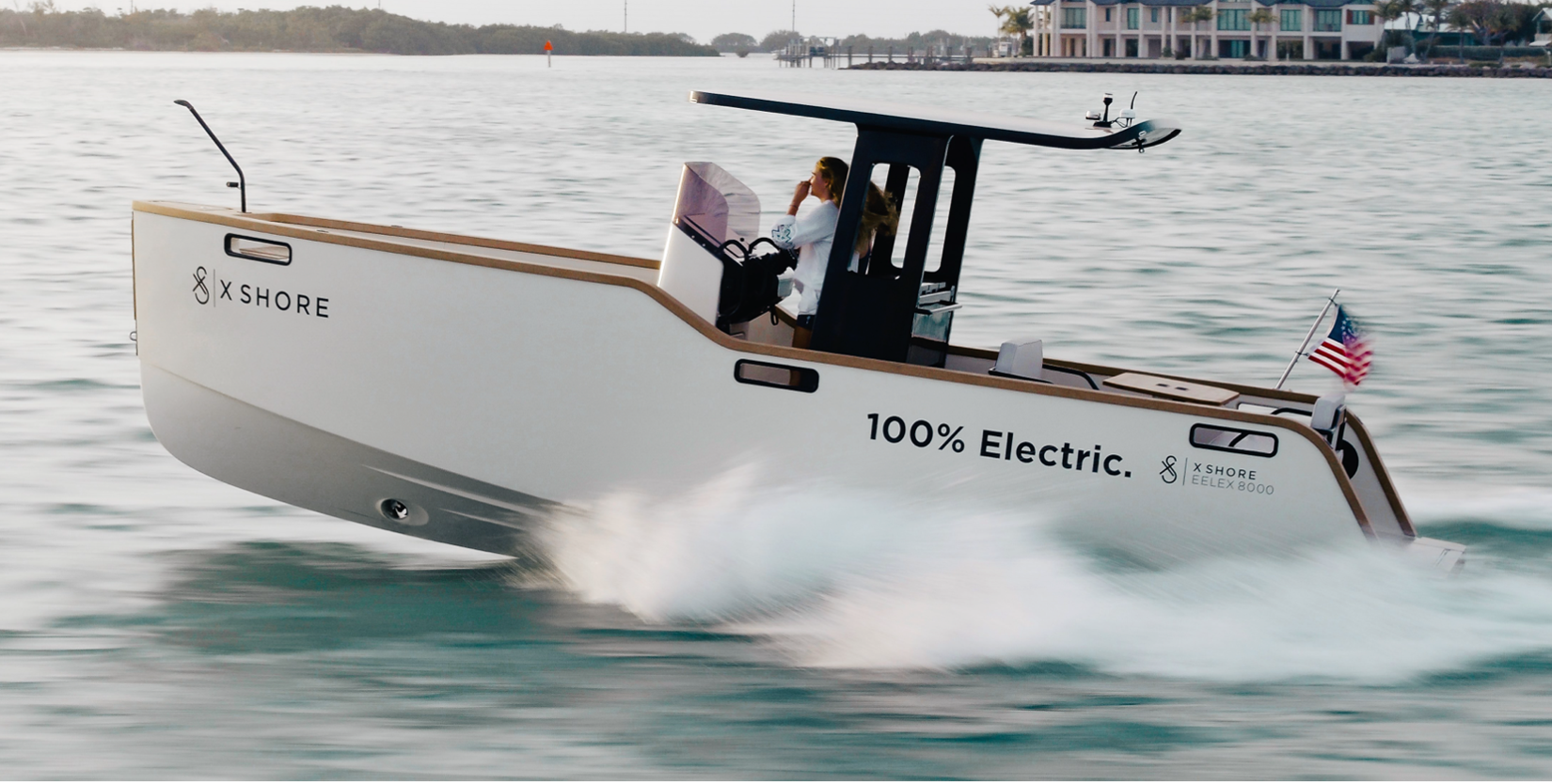
Using an Electric Boat is Different
If your idea of boating fun is to go as fast as you possibly can and get an adrenaline rush with the roar of engines, this is not the boat for you. If you are a big game fisherman and want to speed out 100 miles to the canyons of the continental shelf, look elsewhere.
But, if you are like most boat owners and enjoy day boating, relaxing with friends and family going to nearby islands, beaches, across the lake or up the river, then electric boats are something you should get to know better. They have been built for the times we live in. They require almost no maintenance, and they are economical to operate.
For example, in Virginia a gallon of gasoline at a marina costs $5.50 a gallon, but shore power costs only 10 cents per kilowatt. That means the X Shore Eelex 8000’s 126 kW battery can be filled from 0% to 100% for $12.60.
And, operating an electric boat, much like owning a Tesla, marks the owner as a serious citizen of the planet, interested in nudging along the concept of sustainability and enjoying the finer things of life. Electric boats, of any brand, are not for everyone. For many people, that is their appeal.
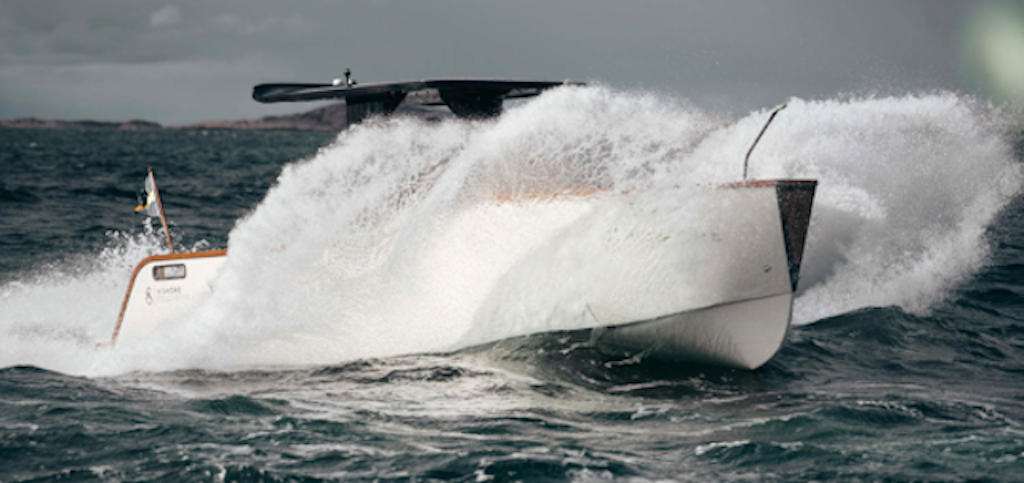
Design
The Eelex 8000 is an unusual design for boats this size, but we think that it’s brilliant because it is well-suited for many applications both in protected water and offshore in rough conditions. That’s a tall order, but the design team at X Shore has done it.
The most notable aspect of the boat is its high bow which has a freeboard of 4’8” (1.43 m), which is as high as many 45’ (13.60 m) center consoles we’ve tested. This enables her to handle snotty conditions offshore with authority, and keep occupants dry in most conditions. This high bow on such a small boat is unusual, but it serves other purposes, such as being high enough to deliver passengers to the dock when moored bow-in, providing storage, and stadium seating.
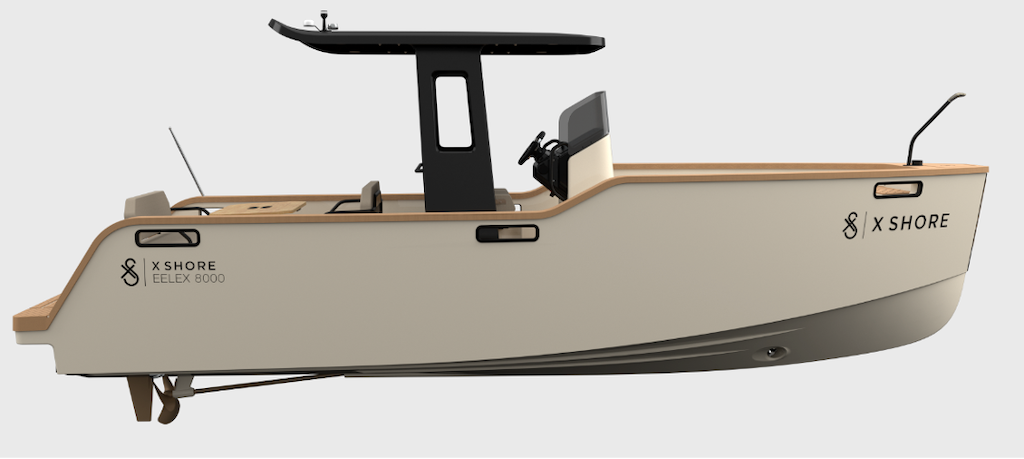
Her plumb bow also serves several purposes: First, it makes it easy to moor bow-in, which is favored in Nordic countries, providing a solid and stable platform to traverse.
Second, it improves operating efficiency in lumpy conditions because – unlike conventional bows which plow into waves throwing tons of water up and out to the sides – this bow, along with its sharp forefoot, slices through waves therefore saving energy. This is why most offshore racing sailboats and the new breed of expedition motoryachts have plumb bows.
A third advantage of this design is that there is no wasted interior space because of bow flare, and molded-in gunwale storage. Rather, with its slab sides, all the boat’s bow volume can be used for storage and support structures for added strength, and aft the usable interior width is maximized.
The Eelex 8000’s sheer has a graceful descent to the stern where its cockpit depth is 27” (.68 m) deep, which is unusual for a 25’10” (7.95 m) boat. Its bottom shape warps from a deep V forward to an 8-degree deadrise at the transom. This is a minimum deadrise angle that will maximize speed and propulsion efficiency, as well as add stability to the boat when at rest.
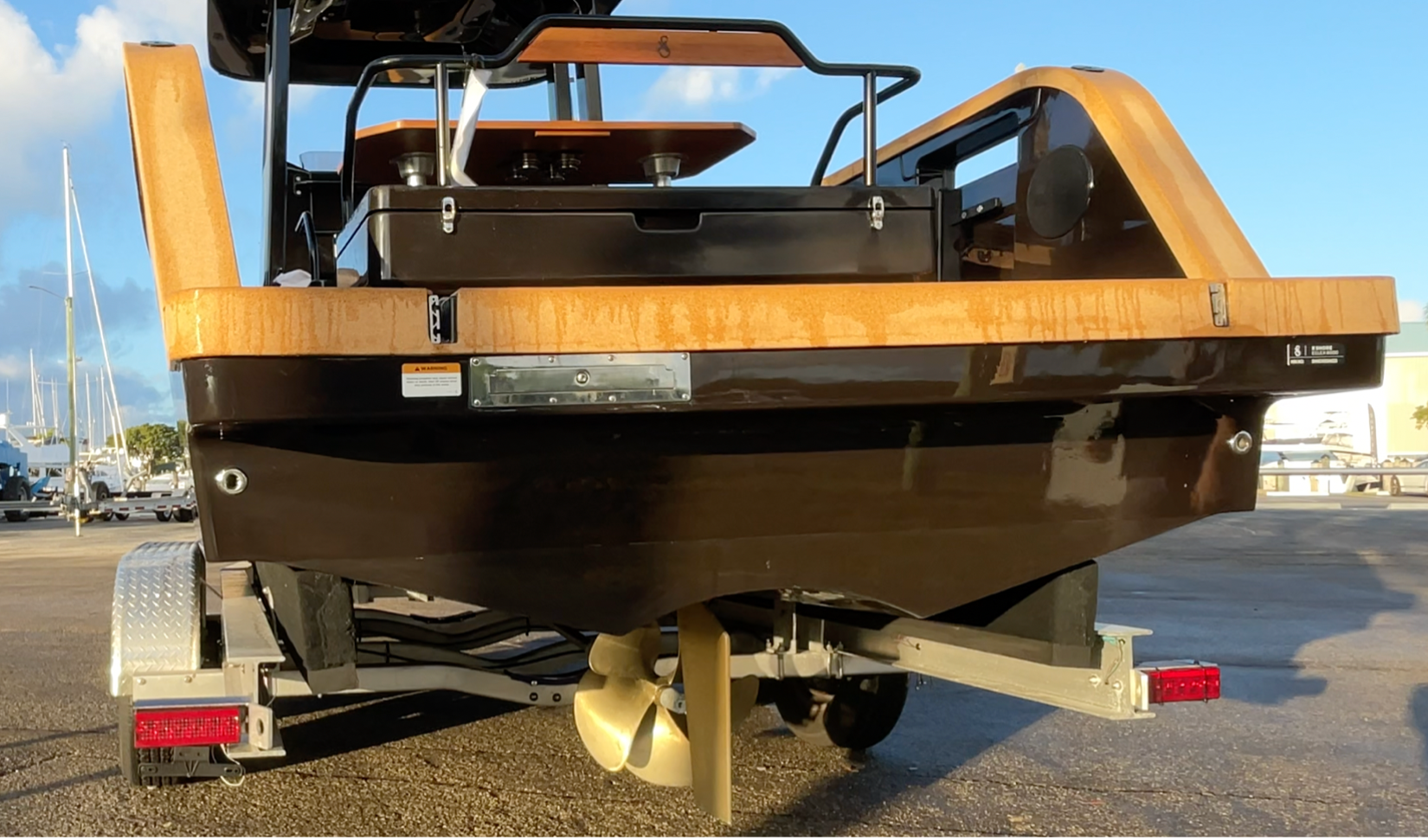
Because the stern deadrise is so shallow, the Eelex 8000 is not designed to be running fast in choppy conditions as the ride will be rough. On the other hand, in the same conditions, if she is operated at displacement speeds, she will be able to handle them and be as comfortable as any boat this size on the market.
Interior Design
The concept of the Eelex 8000 is to be useful in fresh and salt water for as many applications as possible. In order to do that, X Shore designers knew that if they molded in fiberglass seats, a conventional helm and transom, the boat would be locked into being a one (or two) trick pony. So, features such as a live well or in-gunwale storage, or a typical helm console would naturally limit the utility and versatility of the vessel.
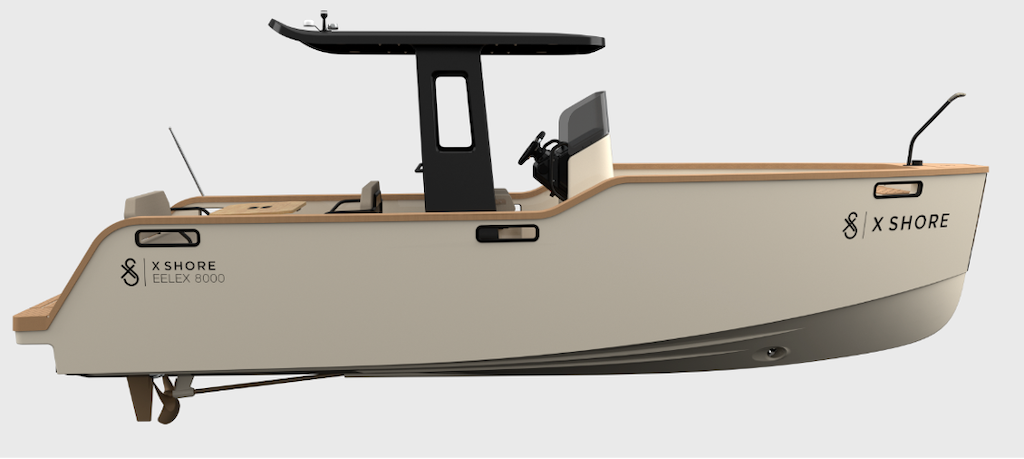
For that reason, the company decided to make its interior as modular as possible so each owner could configure the boat anyway wanted. For example, the boat we tested was equipped with two bench seat modules and a table, in addition to the center console helm and seat/leaning post which is connected to the T-Top.
X Shore says that there are at least 10 ways the boat can be configured. The three modules on our test boat can be mixed and matched or totally discarded. And, new modules are coming.
A new module that will be available on all new boats is the “sun bed” which will go in front of the helm and be above the hatch to the storage compartment forward. This new feature has a ladder down and a porta-potty can be placed there. Other modules include one that holds large bins for ice, ideal for keeping beverages cold, and others that can hold scuba tanks.
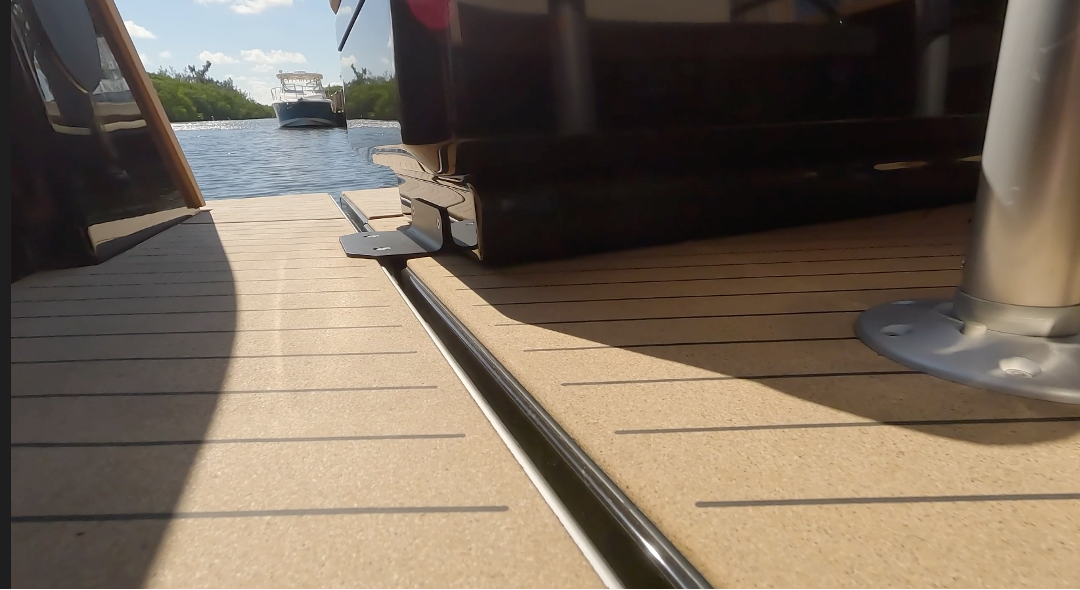
Two 19’ (5.74 m) parallel aluminum tracks run fore and aft from the bottom of the steps forward. All of the modules are locked down on this track with easy to remove fastenings. The modules are simple, light-weight and minimalist, in keeping with the utilitarian theme of the boat.
Construction
The hull and deck of the Eelex 8000 are made of fiberglass cloth and mat that has been “pre-pregged” with expensive epoxy, rather than with polyester of vinylester resins which are standard in the industry.
The T-Top is made of carbon fiber which has also been “pre-pregged” with epoxy. Epoxy does not permit water migration, so the hulls are immune to blistering, and most respects epoxy is superior to the resins most builders use. The cantilevered T-Top is rated to carry 1,500 lb. (681 kg.) of cargo.
The deck, stair treads and cap rail all are made from a sustainable cork and resin composite. This is in stark contrast to premium-quality boats in the class of the Eelex 8000 which often use teak on cap rails, decks and stair treads. Cork on a tree re-grows after it is harvested and the tree is not cut down, unlike teak trees.
This is a very unusual combination of materials, but it doesn’t take long to get used to. The cork composite is skid resistant, easy to clean and has a lot more eye-appeal than typical fiberglass decks. X Shore says that its cork material reduce overall noise and is more adaptable to temperature than wood. We’re told that the cork composite is also easy to repair, if need be, but since the cork is embedded in resin, damage is not likely.
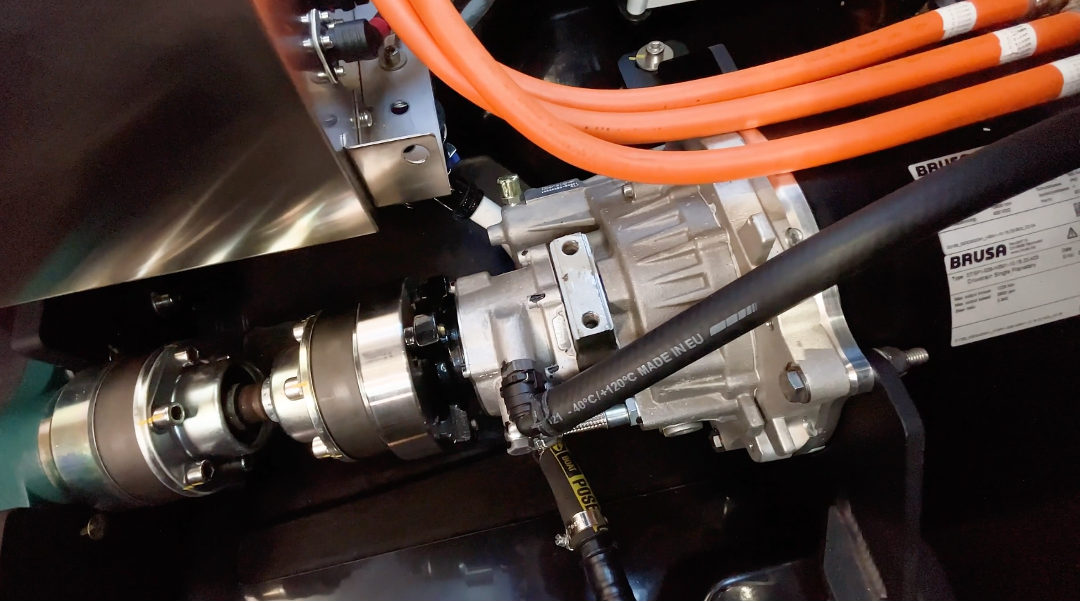
Propulsion System
The powering of every boat is a delicate balancing act to get enough energy on the boat – be it kilowatts hours or gallons of gasoline – then feed it to an engine with enough power to accomplish the boat’s missions.
The heavier the boat, the more drag it has, the harder it will be to push. The harder it is, the greater horsepower needed, or in this case, the more kilowatts. The faster the speed needed, the higher the kW draw, and the larger the batteries must be.
Marching to a Different Drummer
The raison d’ etre of the X Shore Eelex 8000 is to provide a zero-emissions day boat for a variety of applications and conditions in fresh and saltwater. Further, her drive train must be whisper quiet. Overall, she must be a harbinger of things to come in boating, not the same old shell of a day boat with an electric motor. Finally, her design and performance must be inspirational enough to lead a very conservative industry into a sustainable future.
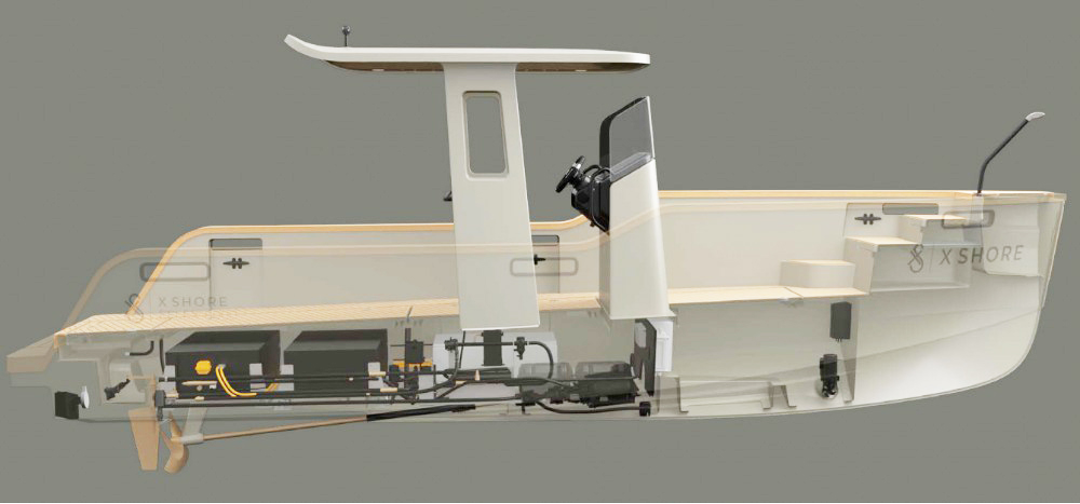
The Drivetrain and Battery
Our test boat was powered by two Kreisel 63 kWh lithium-ion battery packs, totaling 126 kWh, feeding a Bursa 175 kW peak, 145 kW continuous, electric motor. That’s it. The motor has one moving part – its rotor. The transmission has two – which don’t touch.
X Shore states that the battery packs are expected to live for 3,000 cycles, which means about 10 years for commercial vessels which are used almost every day, and considerably longer for recreational boat owners. The batteries are easily removed, and company has a trade-in policy if significant improvements in battery technology and capacity become commercially available.
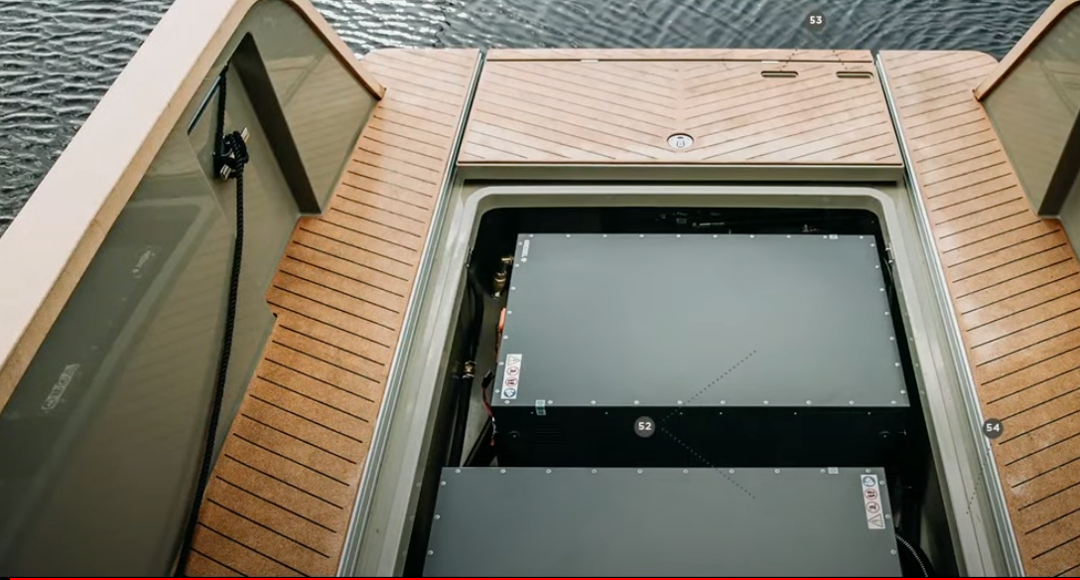
The Search for Performance
By reducing motor heat, drivetrain friction, hull drag and propeller slip, electric boat builders can squeeze improved performance out of their batteries. In this regard, X Shore has dedicated cooling systems for both the drivetrain and the battery packs, plus a magnetic transmission that steps down the motor’s RPM by a ratio of 2.84:1 without gears.
The Eelex 8000 has a nearly flat bottom from amidships aft to maximize hull efficiency and lift. When it comes to prop slip, at 1200 RPM and higher, its propeller is about as efficient as can be. See our data grid at the beginning of this report.
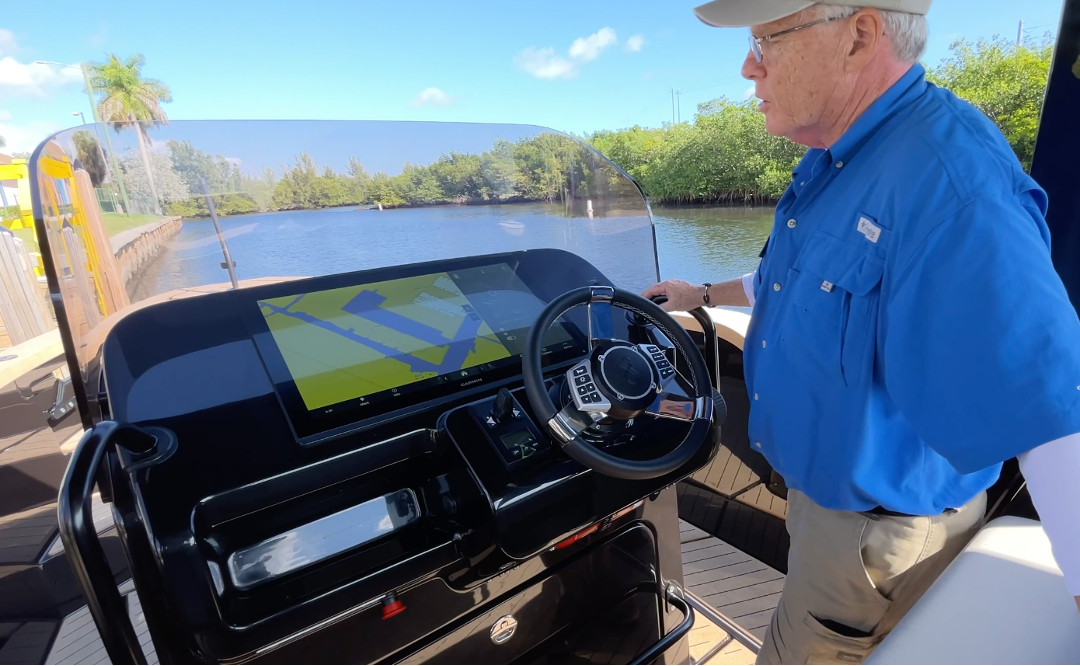
Boat Operation
The helm is to the right side of the center console, with the 24” Garmin screen offset to port so that the panel showing all of the propulsion system data is directly in front of the operator. The compass is digital. There are buttons on the touch screen for three speed settings—
*Power of Silence
*Cruiser
*Speedster
These three levels are designed for safety and longer battery life. Each level (you can think of them as gears that need shifting) limit the kW that can be fed to the battery. When translated into speed, think of the “Power of Silence” being under 10 mph, “Cruiser” providing enough kW to go from 10 to 20 mph, and Speedster being over 20 mph, with the boat being able to top 30 mph.
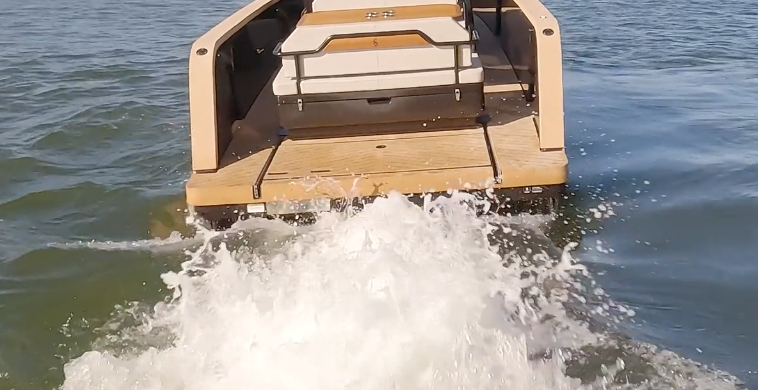
Performance
We conducted our speed tests in protected flat water in the ICW in 78-degrees F temperature, 60% humidity, neither of which are particularly important when testing electric boats. With the two sofas and table weighing 332 lb. (151 kg.) and three people aboard, which added 625 lbs., and the total tested weight was about 6,512 lbs. (2,960 kgs). The prop used was 19” x 24” x 5 blades.
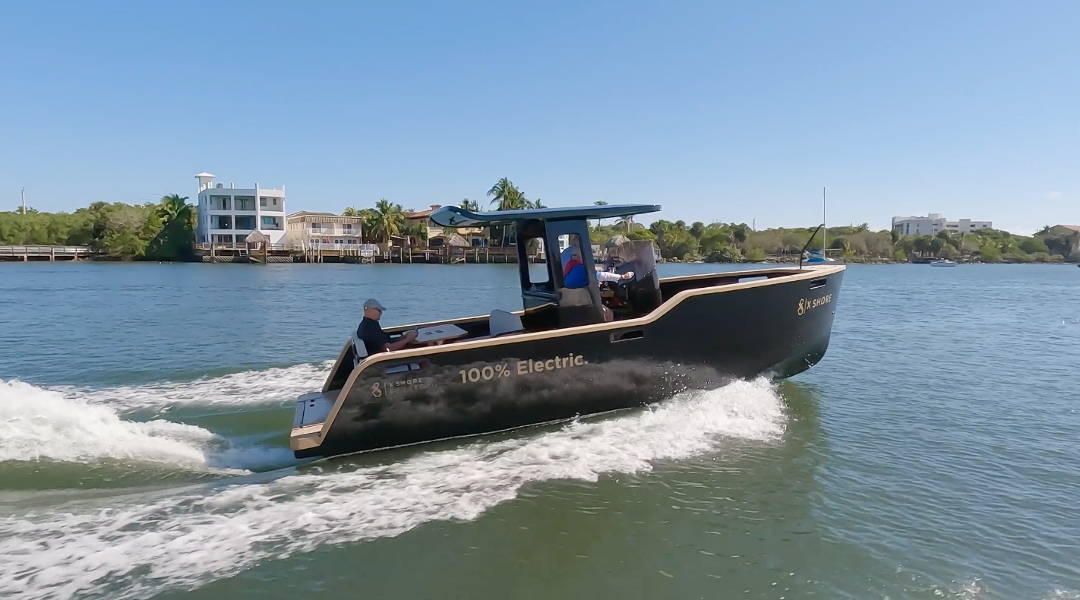
Test Protocol: We started our test at 200 RPM, going quite a bit lower than the 600 or so rpm that we see on most internal combustion engines at idle. Then we took data readings every 200 RPM until we got to 1660 rpm which was wide open throttle. This is the lowest RPM we’ve ever tested a boat at top speed. Reciprocals were run at each RPM and data recorded was averaged. Four hole-shot runs were made in quick succession and averaged.
Top Speed of the Eelex 8000 was 33.5 mph turning 1660 rpm for an endurance of 39 minutes, going 22 miles, with 10% of the battery capacity in reserve. All range numbers have been calculated on 90% of the battery capacity. Power setting: Speedster.
The Most Economical Planing Speed was at 1200 rpm where we recorded 22.5 mph, for a range of 29 miles and a duration of one hour and 16 minutes. Power setting: Cruiser
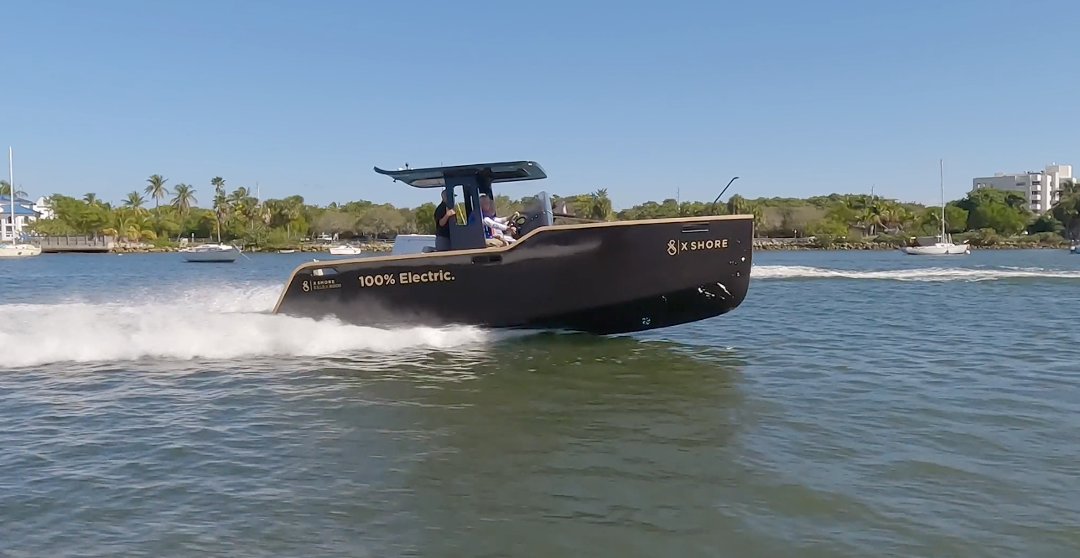
Wakeboard Speed of 10.3 mph gave us 2 hours and 42 minutes of endurance. Unless someone wants to hog the board all of that time, total elapsed time of a wake boarding outing can last much longer, depending on the time taken between rides. Power setting: Cruiser.
The Slowest Speed we recorded at 200 RPM was 3.25 mph, burning just 1.98 kilowatts. The boat will go slower, of course, when docking. Power setting: Power of Silence.
The Best Speed for long-range, quiet and enjoyable cruising is 600-650 RPM and a speed of 8 mph or 7 knots. This will provide an endurance of over 6 hours for a distance of about 50 statute miles, depending on load and conditions. Power setting: Power of Silence.
Acceleration Times for the vessel are exceedingly quick, as is expected for electric power. BoatTEST calculated “time to plane” in this test by noting when the bow began to drop. There are other ways of measuring when the boat is planning, but this is the most accurate way to compare boat to boat.
*0 to Plane (bow drops): 3.24 Seconds
*0 to 20 MPH: 5.75 Seconds
*0 to 30 MPH: 8.69 Seconds
Handling at the Dock
If you have experience docking a single engine inboard, or even a single outboard, you know it can be challenging unless you know what to do and have some experience. Let us put your mind at ease: docking the Eelex 8000 is easy because of its standard bow thruster.
Because the boat has high torque and a large 5-blade prop, when the boat is put in gear she moves. Unlike single inboard and outboards which typically have small 3-blade props not made for backing, the X Shore’s 19” x 14” x 5 grips the water and moves the boat. For that reason, all it needs when you get in position near the dock, are little “bumps” of the throttle in forward and reverse to maneuver the stern port or starboard. Then, use the bow thruster to move the bow, back and forth until you’re in. Easy peasy.
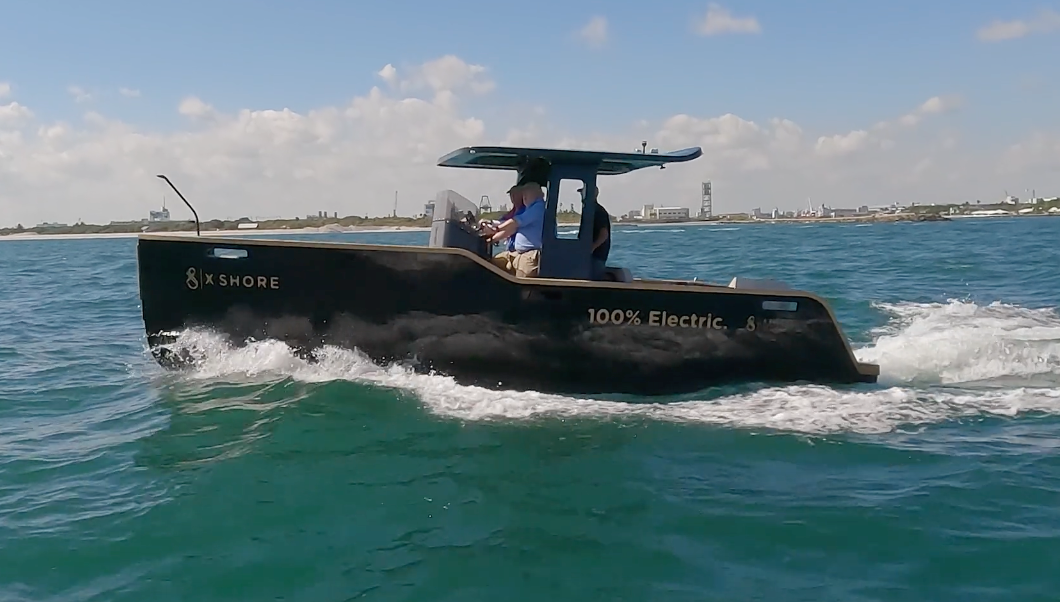
Handling Offshore
At higher speeds, depending on the conditions, she rides on her bottom amidships and we took hardly any spray aboard. We found her turning radius to be relatively tight, depending on speed, of course. Her large 5-blade prop has a firm grip on the water and makes her responsive to the helm, both fast and slow.
At displacement speeds she rides over swells and cuts through short chop. And that is the way to drive her not only to extend range, but also for a more comfortable ride. Remember, she has only an 8-degree deadrise at the transom, so her bottom is relatively flat from amidship aft.

Range Extender Mode Stops “Range Anxiety”
One concern some people have about electric boats is their range on a single charge. All boats can run out of fuel, a fact that keeps Sea Tow in business. X Shore has a solution for “range anxiety” – something no ICE engine has.
No matter how fast or slow the Eelex 8000 is operated, when the battery is drained to 10% of its charge, which is 12.6 kilowatt hours, it automatically goes into what the company calls “limp mode.” That limits the kilowatt output which will give leave enough charge to go about 10 miles to get back to port – depending how speed over the bottom.
For example, in our test, the 8000 going 5.85 mph (5.08 knots) would have a range of 12.6 statute miles. If the boat is driven faster, it will of course be less range, and slower it will be more.
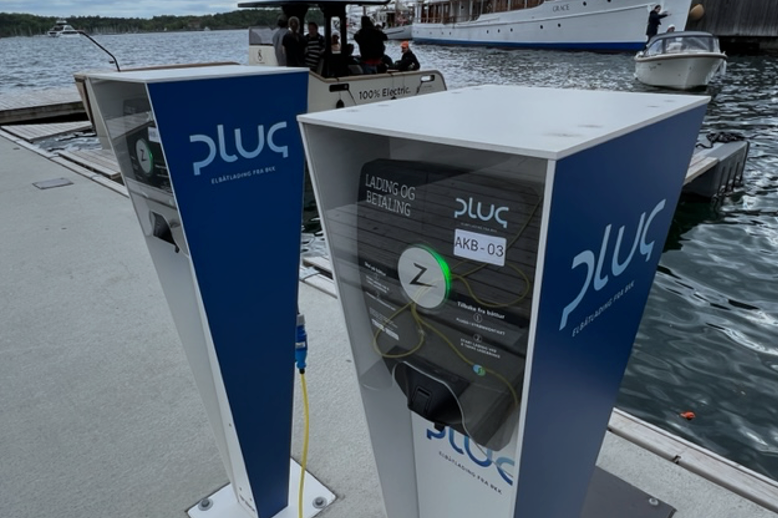

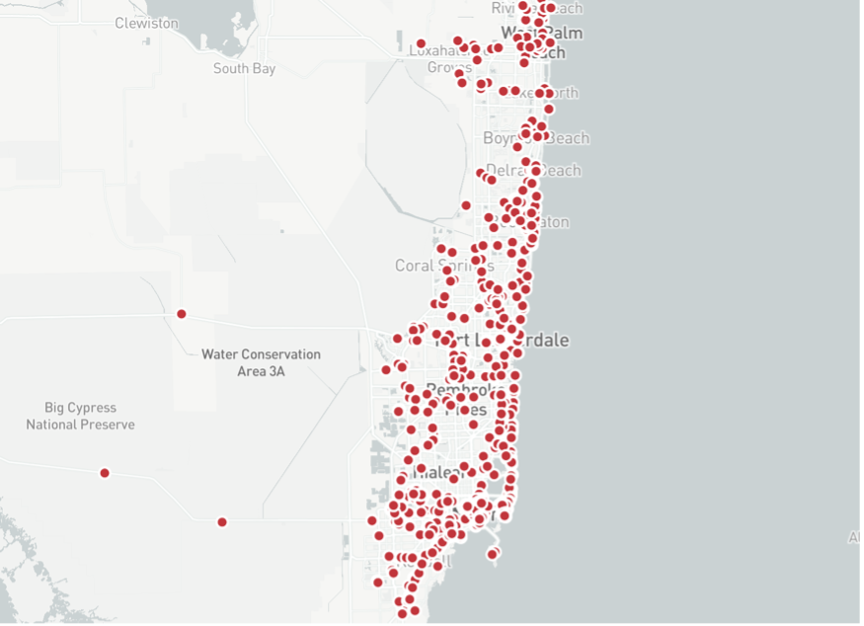
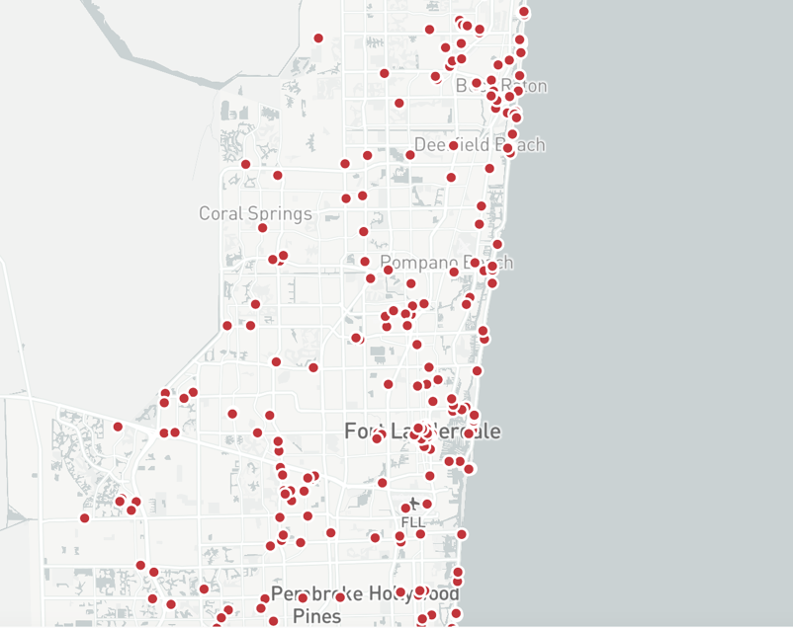
Slow Charging
Slow charging with 240 Volts can take 4 to 10 hours to charge a typical electric car battery according to the USDOT. X Shore uses the standard automobile plug and has “Juice Booster” adapters for marina use 240V 50 Amp shore power. There 9,623 marinas in the U.S., according IBIS World. Most large boat marinas have 240V 50 Amp shore power.
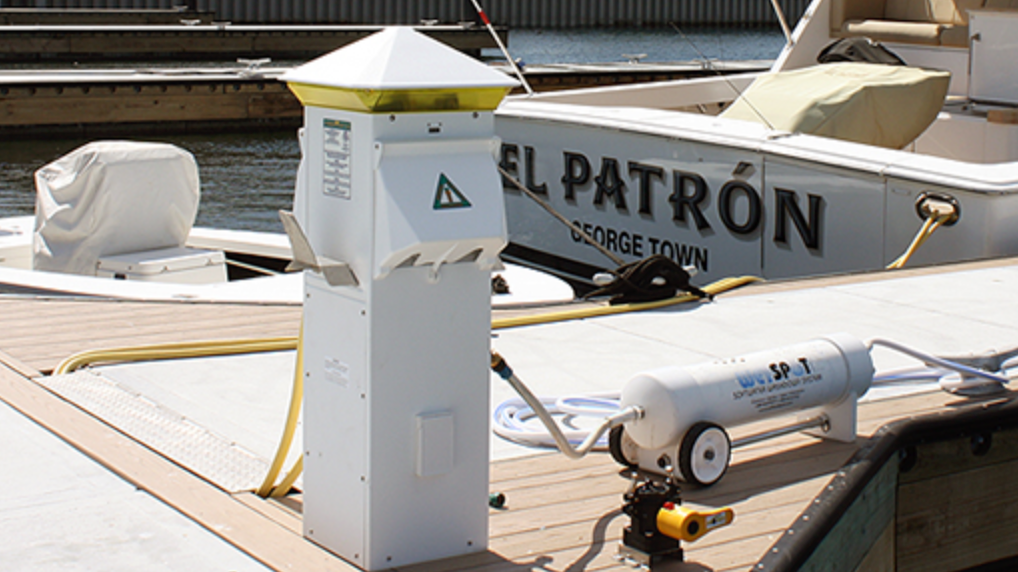
For example, there are 33 marinas in Ft. Lauderdale and most have 240V 50 Amp. One friend of Boat TEST who has an X Shore says he’s made over 100 day trips and has always been able to pull into a marina in the evening, plug in, and have a fully charged battery the next morning.
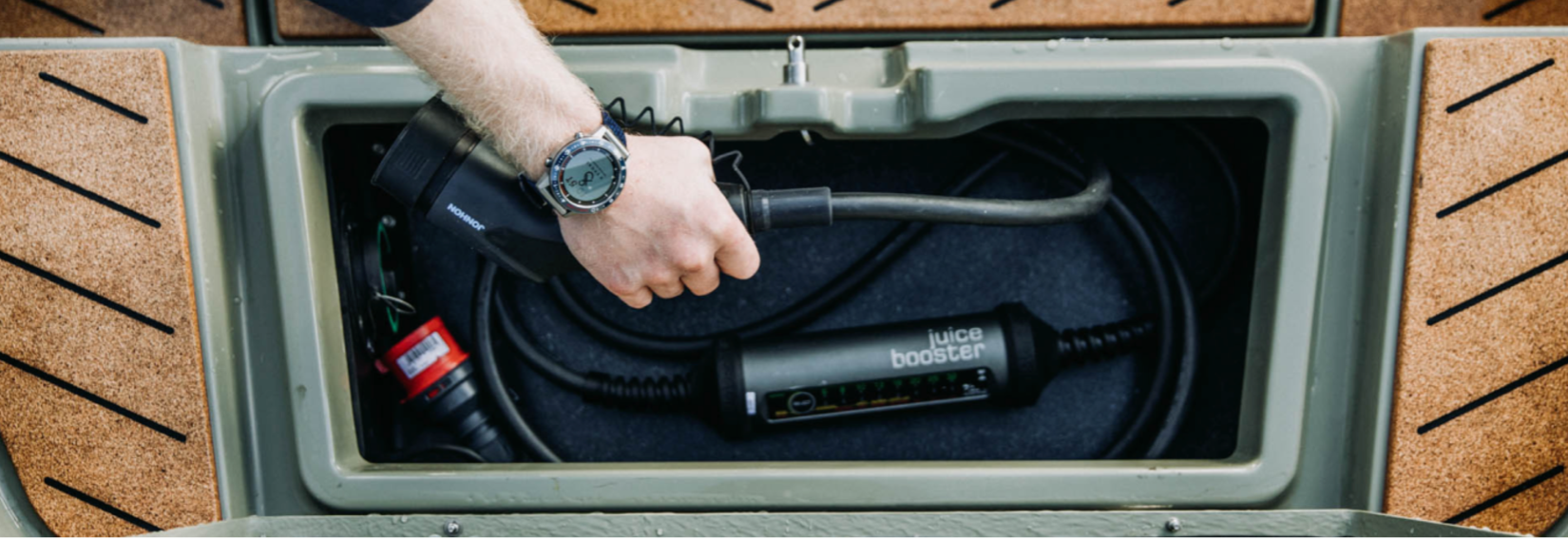
To find the marinas in your area with adequate shore power for charging go to the Waterway Guide to find the marinas by state and city: https://www.waterwayguide.com/directory/marina
Between automobile chargers, marina shore power, and even home 240V charging that has been equipped for boat charging, there are plenty of places to charge.
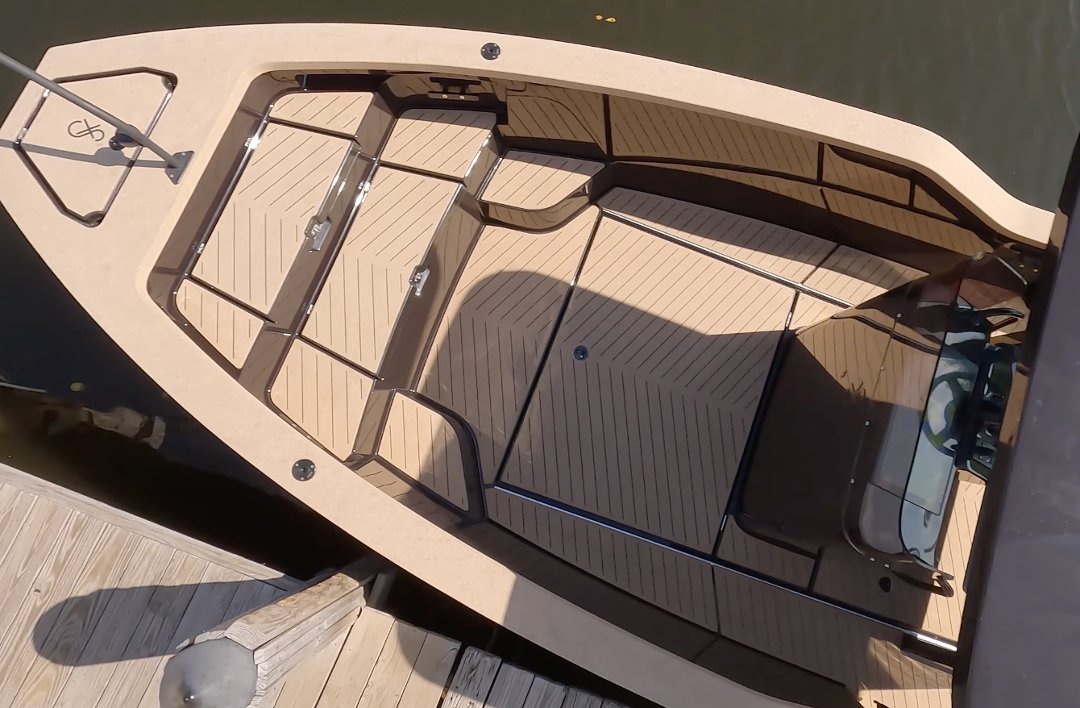
Bow to Stern Inspection
The Bow: The Eelex 8000’s plumb bow services a number of purposes: it provides a solid platform from which to step ashore and board when mooring bow-in; it maximizes useful interior space; and it is the most efficient design to cut through waves without pounding into them.
There is a rail projected forward to aid entrance and exit from the bow, the preferred method of mooring in Nordic countries. In the U.S. and elsewhere where bow-in mooring is not customary, this rail may be removed by the X Shore dealer.

Anchor locker. Under the forward hatch is the anchor locker. While the boat comes with an anchor and rode, there is no provision in the locker for handing the anchor, nor is their provision for a windlass, tie-off cleat, or attached ring or pad eye for the bitter end. Each individual owner can fit out the anchor locker to the application required with the help of the X Shore dealer.
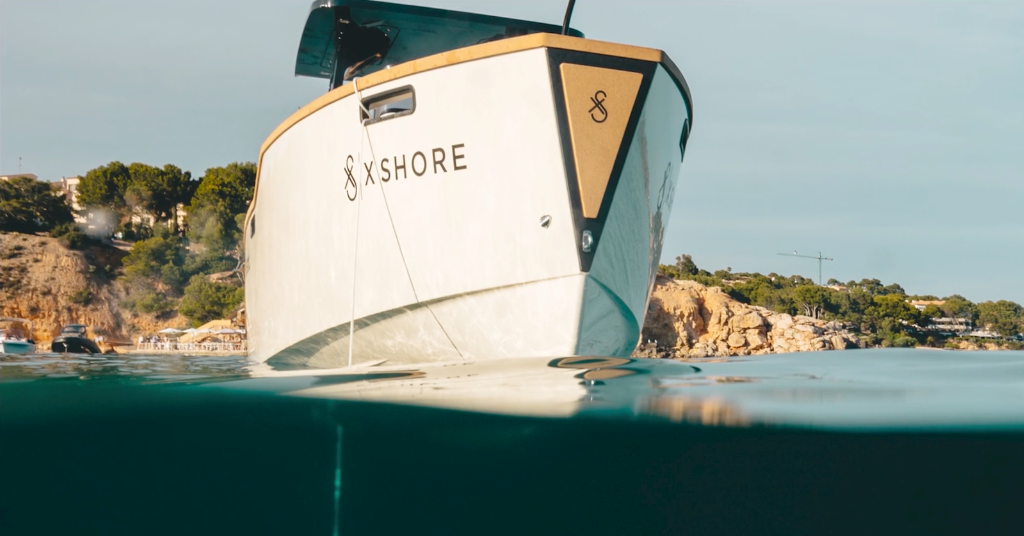
Operators can simply throw the anchor over the side, run the anchor line through the hawse hole forward and tie-off on the adjacent cleat.
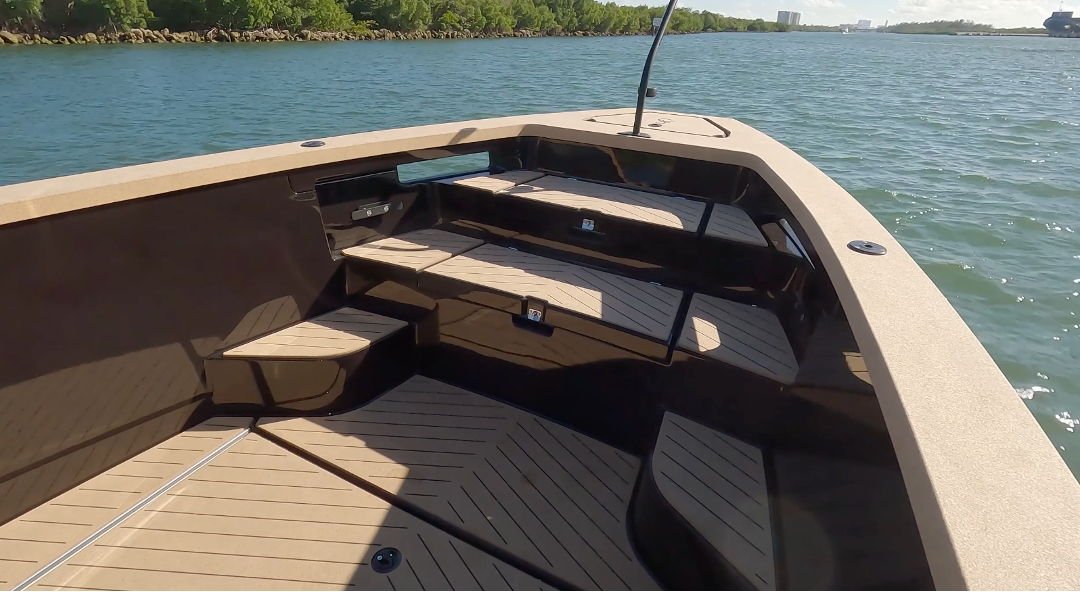
Steps and Storage. There are four steps up from the deck which makes for easy climbing. The steps double as seats facing aft, and under the treads are large compartments. The top one drains into the bottom compartment, so it can be used as an ice chest for beverages, but it is not insulated to our knowledge. The bottom compartment has no drain, and should have one onto the deck.


Forward Sun Pad. X Shore is now equipping its Eelex 8000 models with what it calls a “sun bed” on a raised structure just forward of the center console. This has an opening hatch which leads to the large compartment below. A ladder is placed there for easy entrance and exit, and a porta-potty may be placed here for relative privacy.
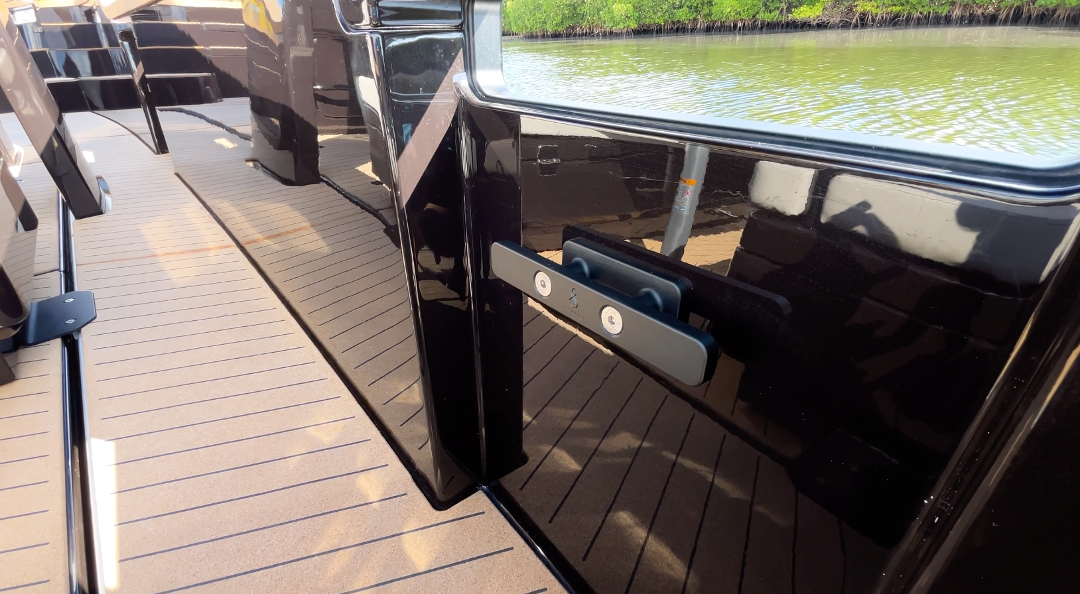
Freeboard is Important
Forward, the boat’s freeboard is 4’8” (1.42 m), which is remarkably high for a 26’ day boat. The reason that it is so high is to make this vessel a seaworthy offshore vessel for commuters in Scandinavia, where many people have summer houses on islands and need to go back and forth in sloppy conditions.
The freeboard aft is 4’3” (1.10 m), which is certainly the highest we have seen on any boats we’ve tested in class. The high freeboard makes the boat dry and the cockpit depth aft is 27” (68 cm) making it safe for young kids, the open stern notwithstanding. We would advise families with young children to install gates aft.
On our test boat there are large stowage compartments under the moveable sofas. There is 12” (30 cm) of clearance on both sides of the center console itself.
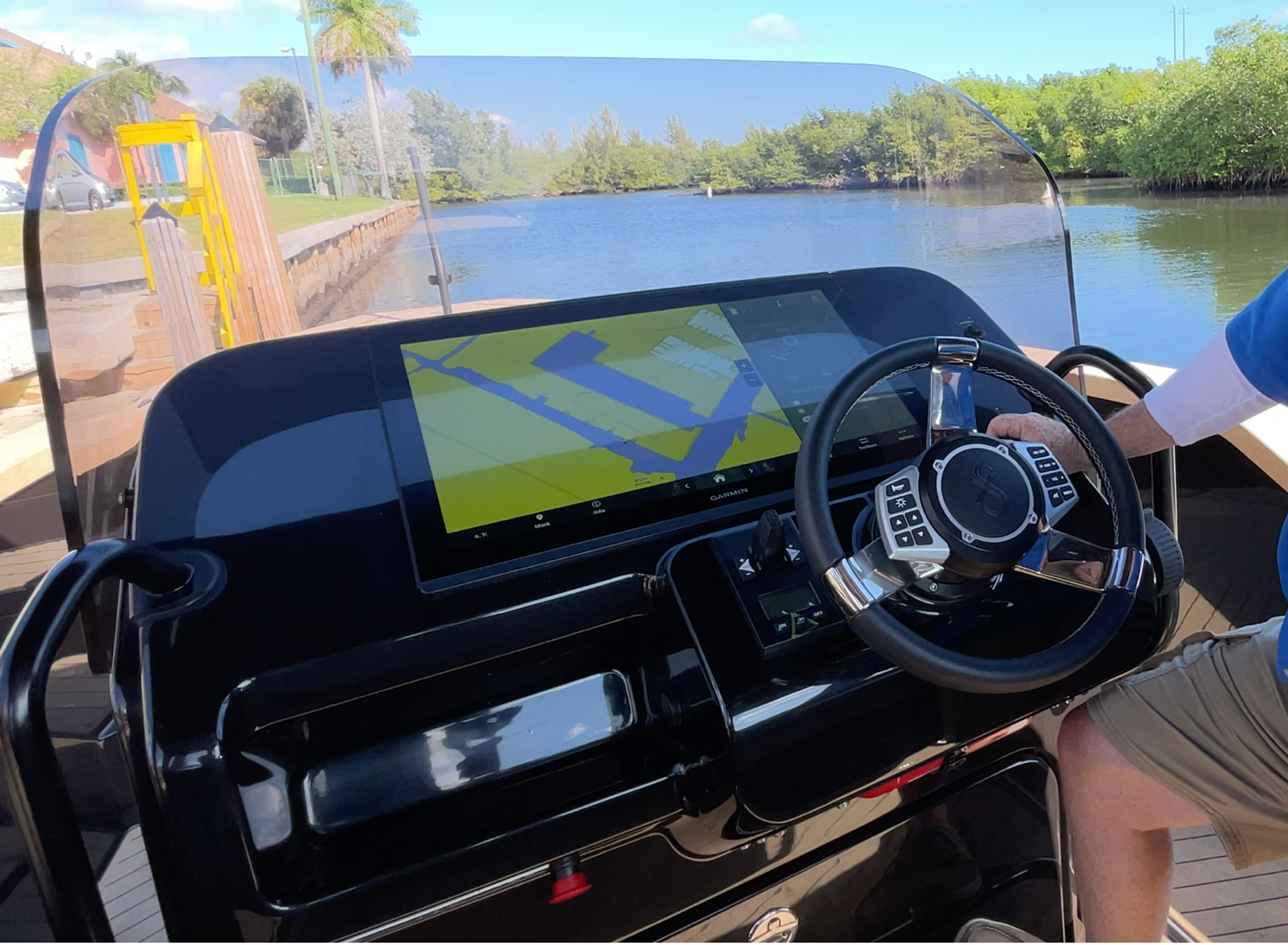
The Helm
Unlike the modules that are attached to the 19’ (5.74 m) long parallel aluminum tracks in the deck, the helm module is bolted down to its own section of the deck. The wrap-around windshield is made of a polycarbonate material that does not distort in the curves. This was chosen instead of a glass windshield because of the added weight of the glass and its frame. We would like to see a rail around the windshield in case someone loses their balance and to aid moving fore and aft.
Multi-Functional Display (MFD)
The boat’s digital compass is incorporated in the 24” Garmin MFD which dominates the dash. It’s canted at just the right angle for good viewing either standing or sitting.
The starboard one-third section of the screen, immediately in front of the operator, is the X Shore touch screen control panel. All controls and monitors for the boat’s systems are located here. Below are the seven dedicated X Shore control screens that come up on the panel when the icons are touched.
We like this integrated approach of having all of the boat’s electrical controls on the MFD screen. First, it keeps the operator’s eyes on the nav screen, instead of having to focus on another screen or panel.
Second, all electrical controls are on easy-to-find pages that can be seen standing or sitting. There is no need to fumble around trying to read the small print on buttons and switches all over the dash. The Garmin MFD also simplifies boat construction, and makes the electrical system more reliable. Most large cruisers these days are all digital.
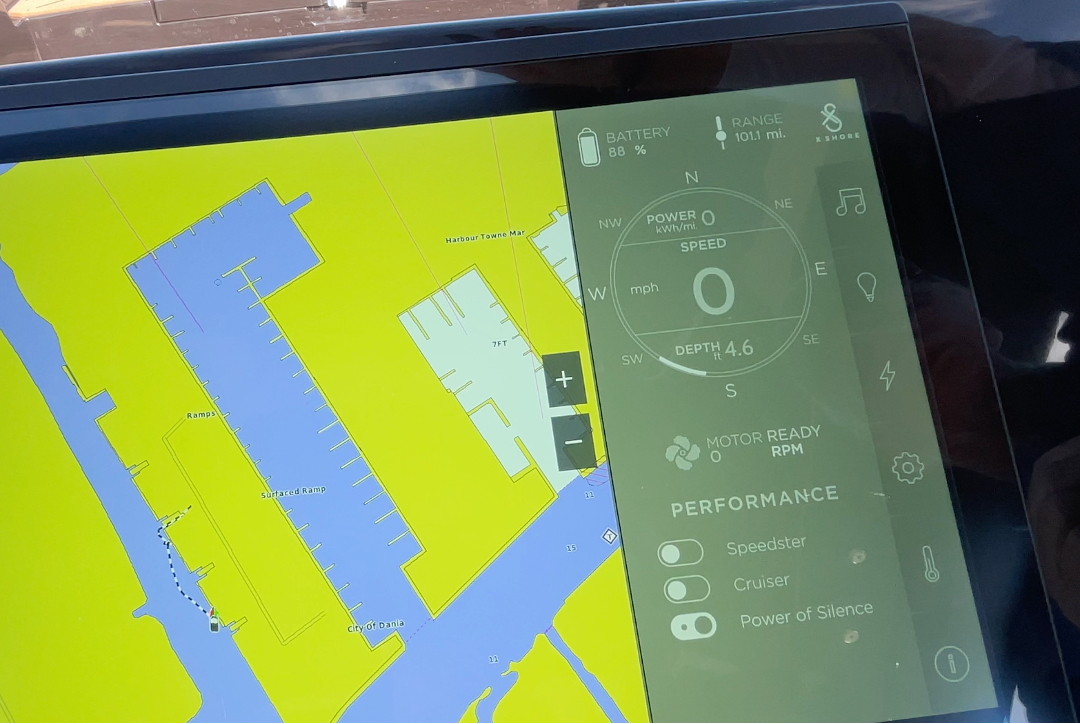
#1 Boat Operation. This is the screen used when driving the boat. All vital information is here. At the top, the battery charge and range in miles at that charge at real time power usage. Lower down are depth and RPM, and the 3 speed settings at the bottom: Power of Silence 50% power, Cruiser 75% power, Speedster 100% power.
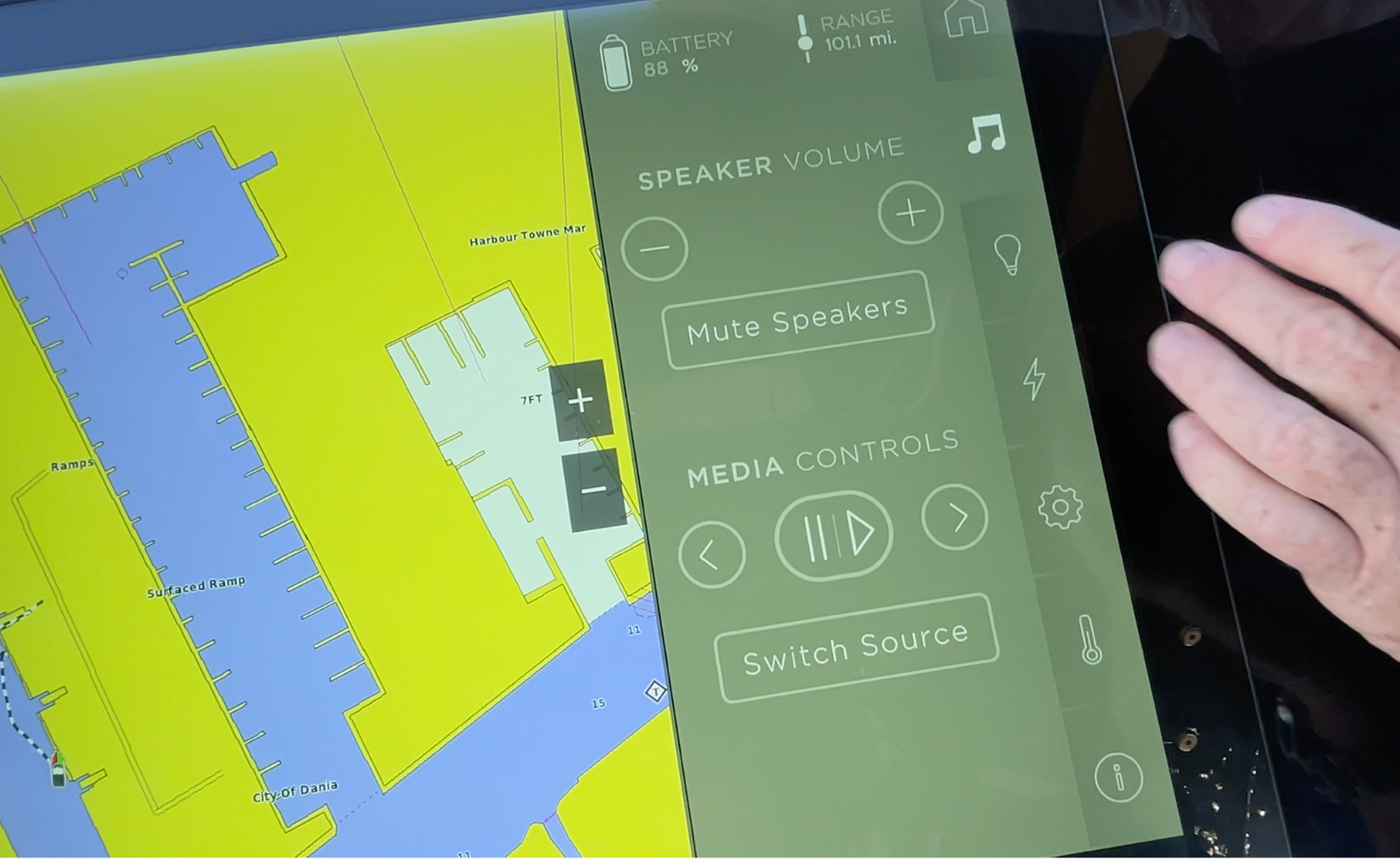
#2 Music/Sound Control. Speaker volume and source control.
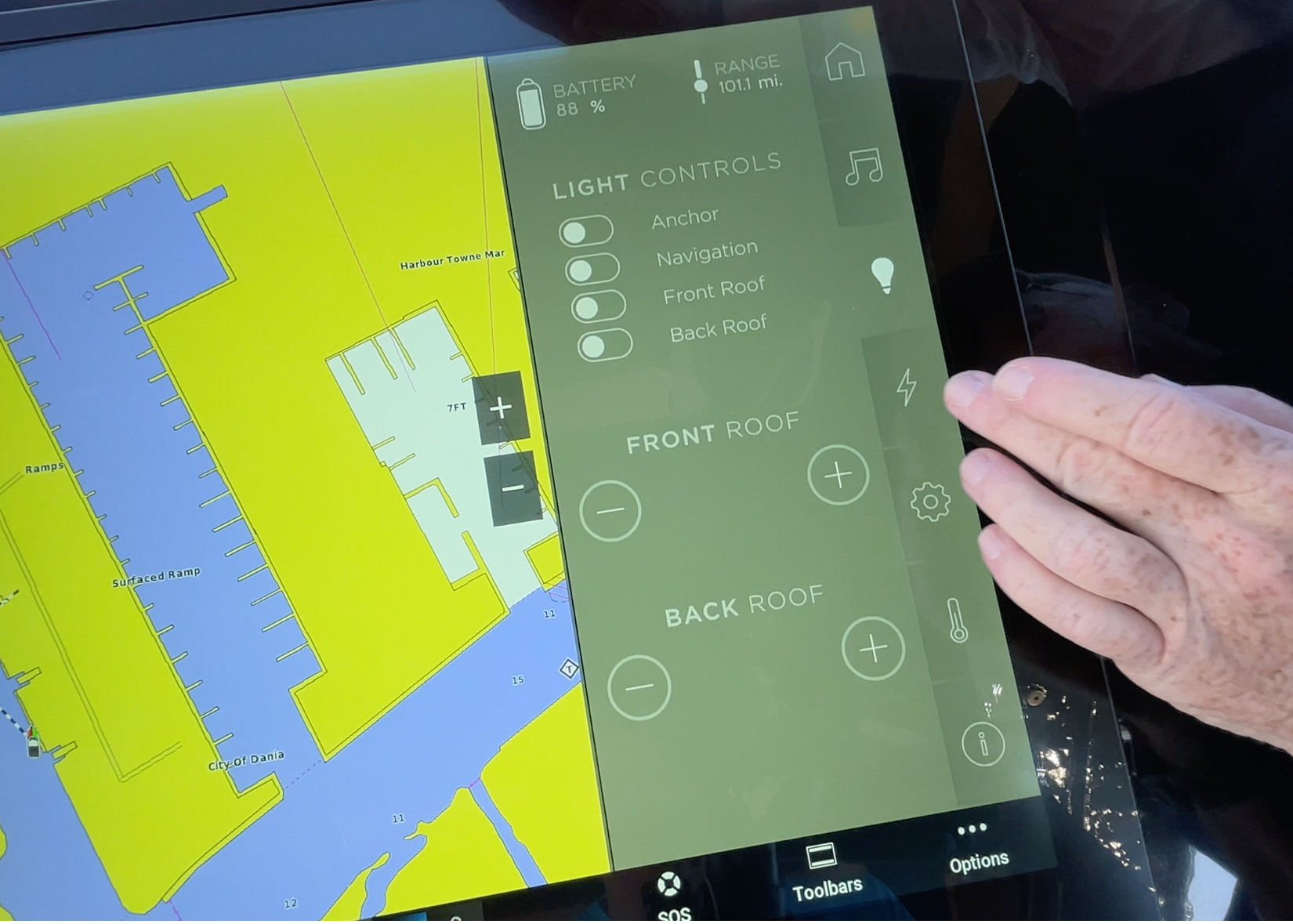
#3 Light Control. These are on/off switches. Note that there are rheostats on the lights on the T-Top.
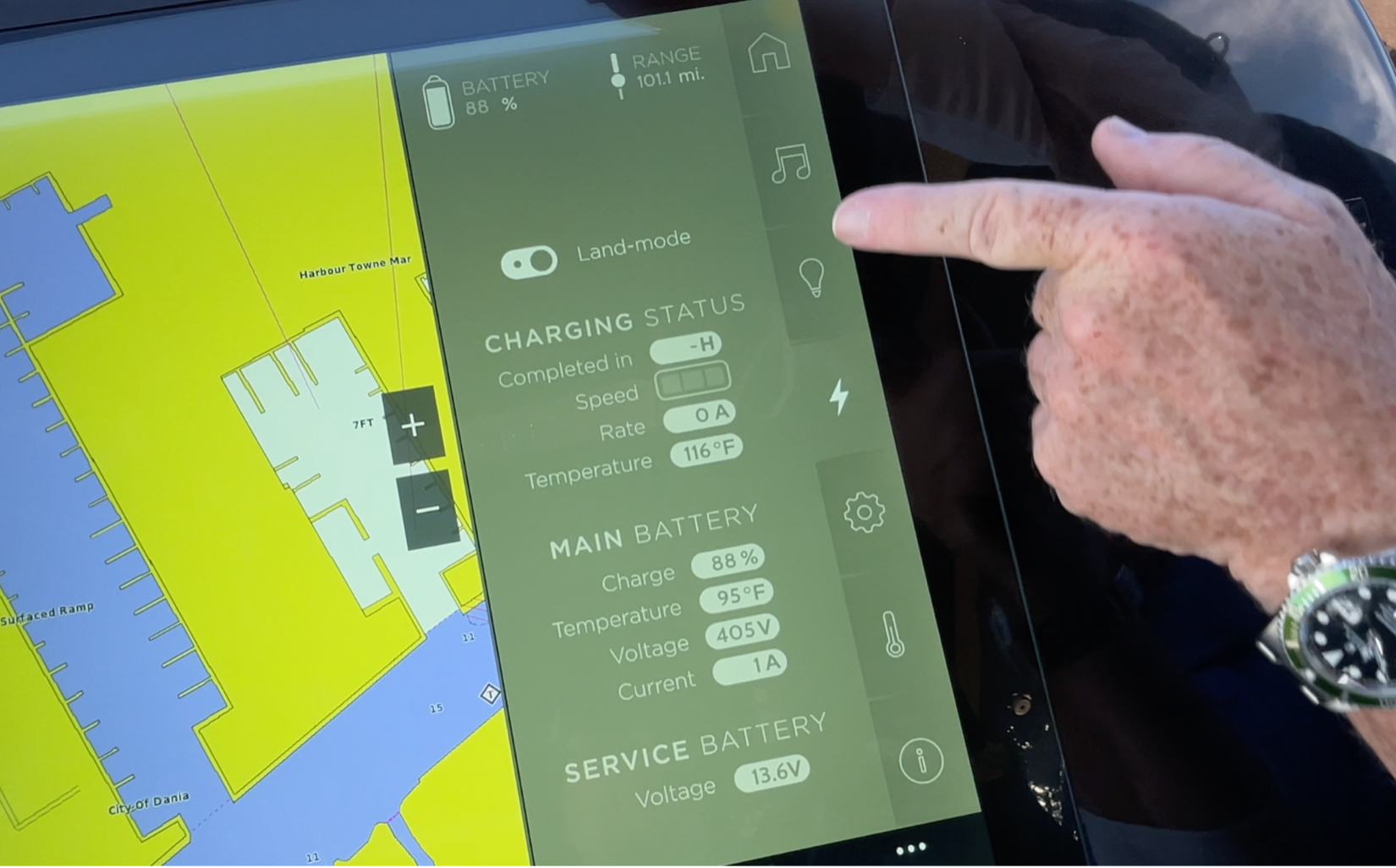
#4 Charging Status. When charging, this monitor screen will give the time to a full charge, charging speed and rate in Amps. It also monitors the house battery.
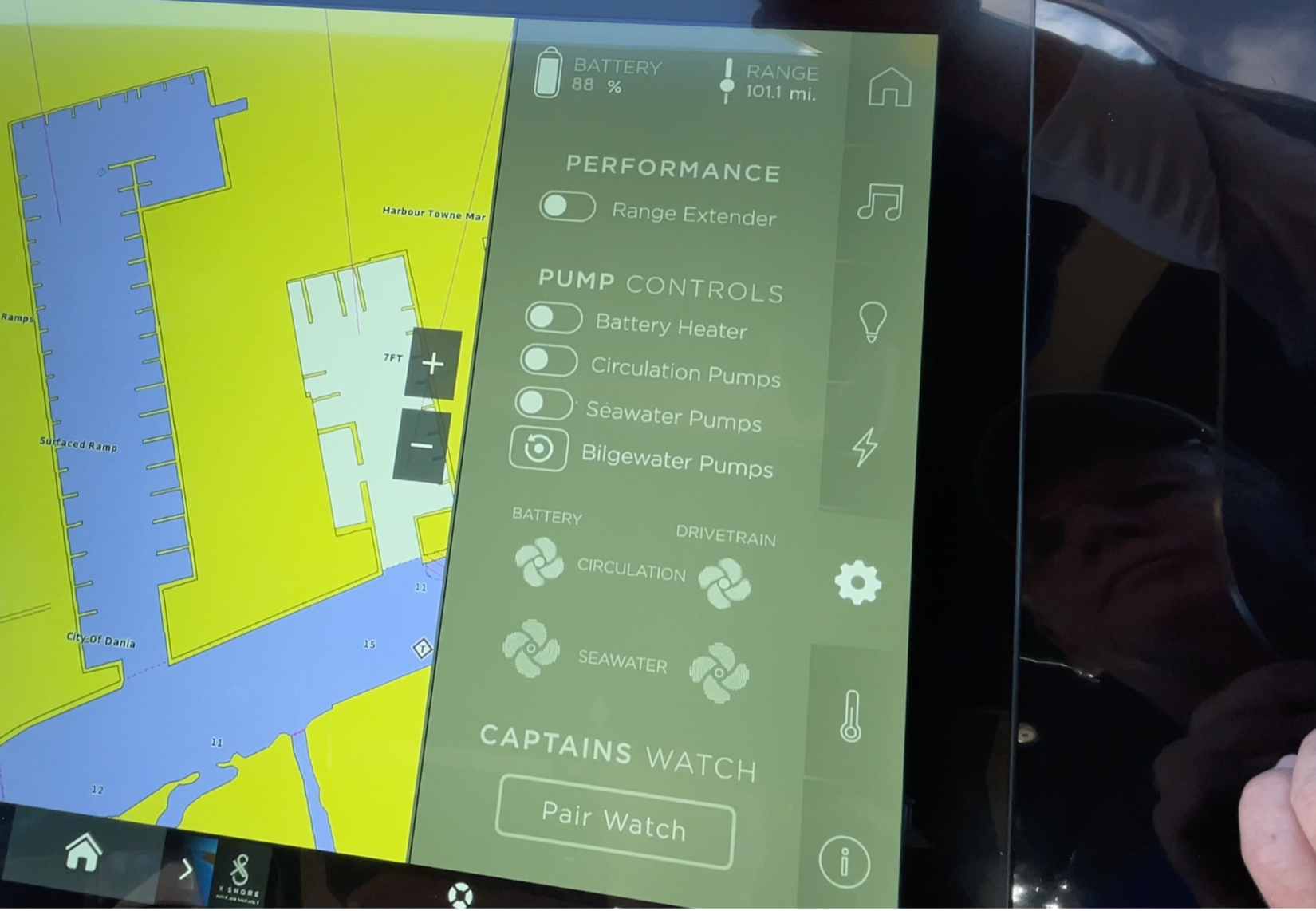
#5 Mechanical Controls/Monitors. This panel is a good place to check before and after each boat use. Circulation pumps and seawater pumps automatically start when the ignition is turned on. The battery heater can be used when charging in cold weather. The “Range Extender” limits power usage to 20% of the battery’s capacity.

#6 Temperature Monitors. While all of the components have their own internal fail/safe mechanisms, it is reassuring to be able to check the temperatures of all components when operating the boat.
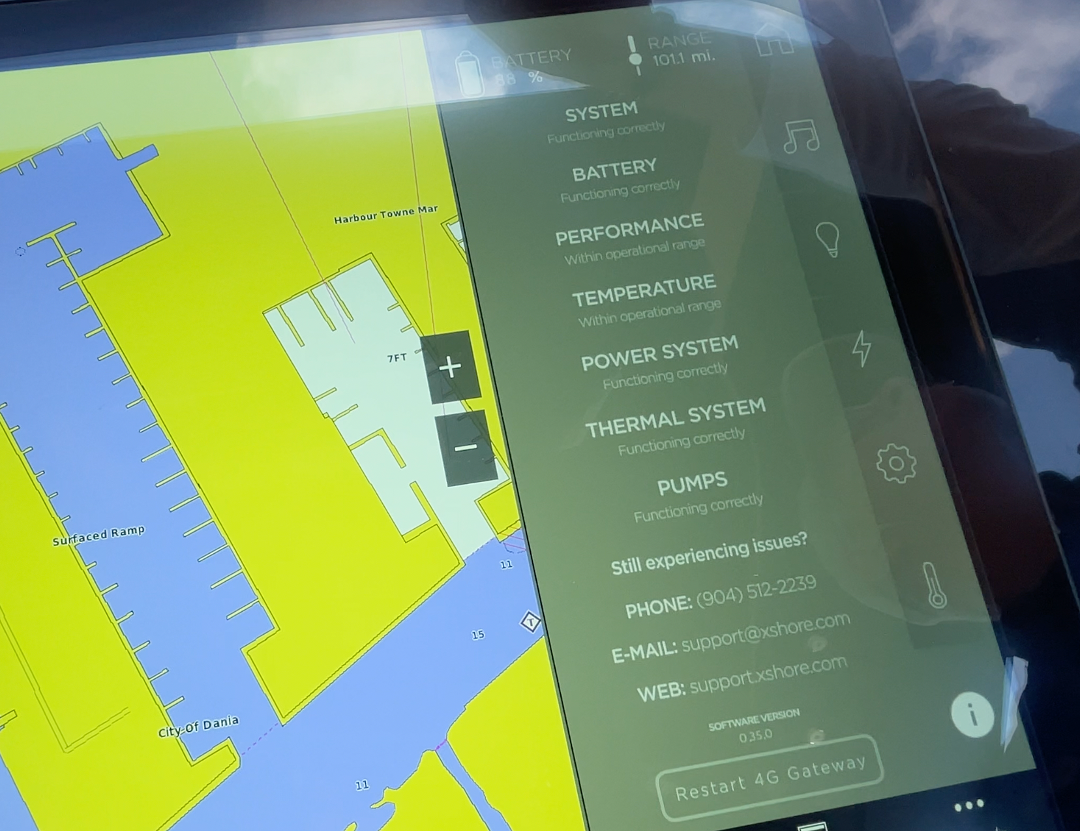
#7 Powertrain Alerts/Assist. This is a helpful screen to make sure everything is functioning correctly, and if not, to identify the faulty system. Any system needing attention will be lit in orange, and if there is a failure, it will become a bright red. We like the help support contact information at the bottom, something we rarely see.
The steering wheel itself has controls on it and this design serves two purposes at once. First, it puts the horn and overhead lighting control on the left side, and the media player controls on the right. In this way the operator can drive the boat and select tunes without having to look away from the course at hand. Secondarily, it saves space on the dash.

We would add a knob on the rim of the wheel in the aftermarket, to make rapid turning easier. There is an electric bow thruster control to the left of the helm, which makes docking easy with the single prop, even for a beginner.
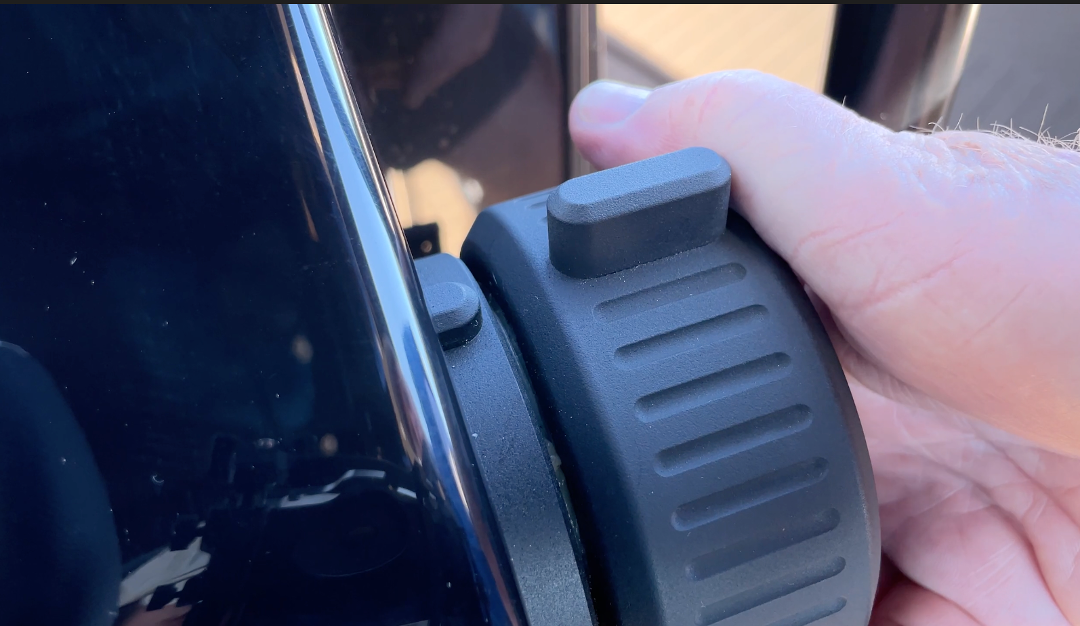
The throttle control is at the side of the console in an out-of-the-way place. This is on purpose to help avoid accidental engagement of the motor. Eliminating the traditional lever throttle control is not only a safety feature, but it also permits more precise adjustment of speed than with a lever.
A second safety device is a power activation button on the side of the console which must be pressed when the controller is in its detent setting for electricity to flow to the motor.

In the U.S., it is Federal Law that every powerboat 26’ (.66 m) and under have an engine kill switch device. Most boats come equipped with an expandable lanyard to affix to their clothing or wrist. Unfortunately, most boaters rarely clip on. But, digital Bluetooth remotes are also legal, and we think more likely to be used.
The folks at X Shore – who are obviously exceptionally safety conscious – have come up a solution to the kill switch lanyard problem. It is a remote device that is more likely to be used than a simple fob in someone’s pocket.
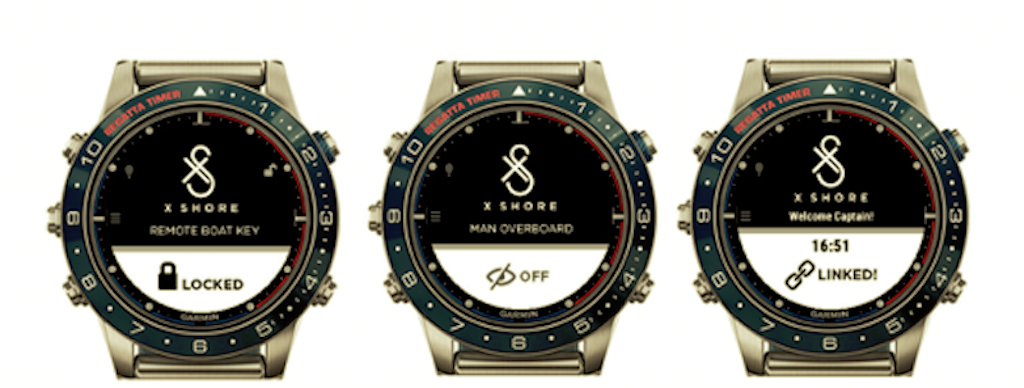
Garmin Multi-Purpose Watch
With each X Shore Eelex 8000 comes a $3,000 Garmin digital watch which has all sorts of functions needed by boaters, including a motor shut off remote kill-switch feature. In addition, the watch displays weather, tide, GPS maps, texts, position, SOS, timer, MOB locator, autopilot control, boat speed, water depth, boat vital signs, stereo control and a dozen other things – and it keeps time, too.
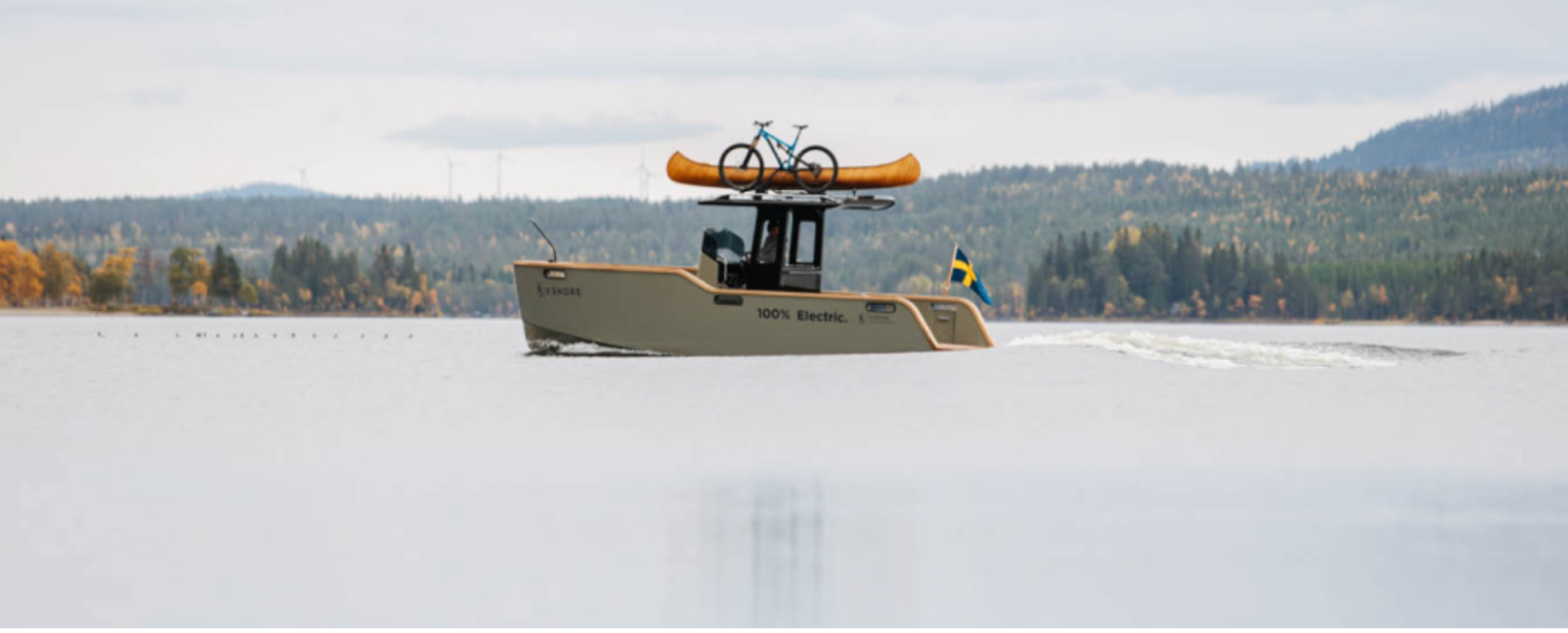
Helm Seat and T-Top
Another innovative feature of the 8000 is the design of the cantilevered carbon fiber T-Top. Virtually all center consoles that have T-Tops have them held up by a matrix of aluminum pipes which are ugly, take up space on the deck, are heavy, often block forward vision, or are incorporated into the windshield. Unlike these T-Tops, the one on the X Shore emanates from the leaning post/bench seat behind the operator, keeping sightlines forward clear.
The top incorporates lights fore and aft, speakers and a tow point at the trailing edge. There are lights on the overhead above the helm which would be more useful at night if they were red. The top is rated to carry 1,500 lbs. (681 kgs.) of cargo.
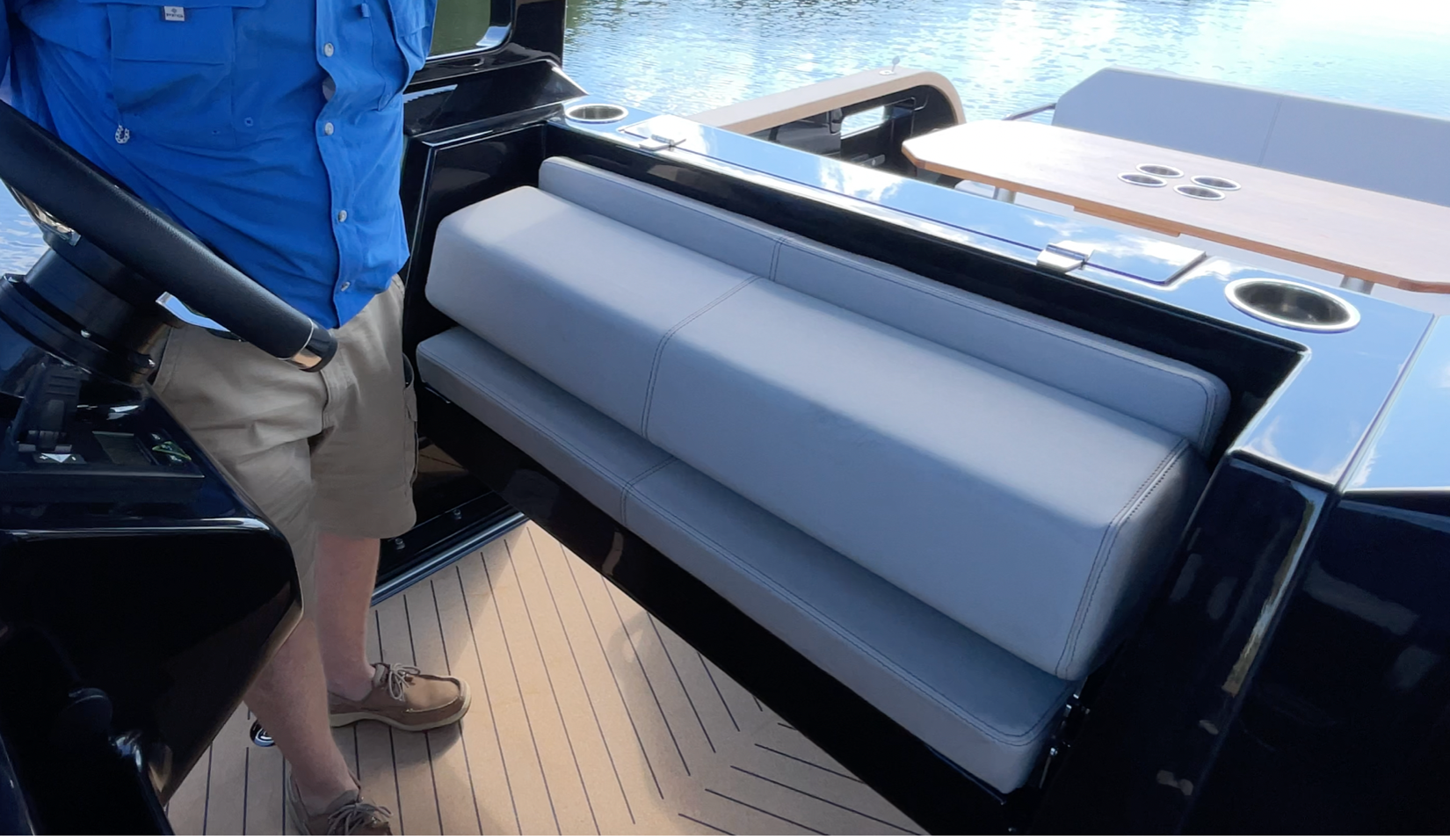

The helm seat is in two sections for the captain and a companion. Both seat has a flip up bolster and can be used as leaning posts. Behind the seat and between the uprights of the T-Top on our boat was a shallow tray under a lid and two cup holders. A foot rest bar is affixed to the base of the console.
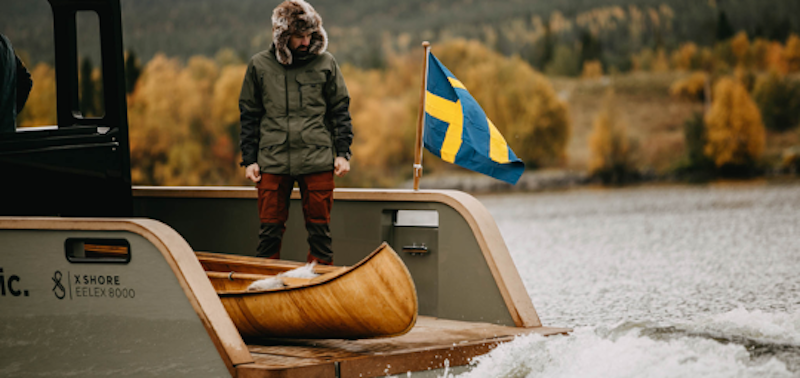
The Cockpit – Use Your Imagination
We’re calling the area behind the helm the cockpit in this boat, and without the furniture aboard it would resemble the bed of a quarter-ton pick-up truck – except at 11’ (3.32 m) fore and aft, it’s longer than most normal pick-up trucks. This is the way the base Eelex 8000 boat comes – no furniture. The reason is that everyone will have their own take on how they want to use and equip the boat.
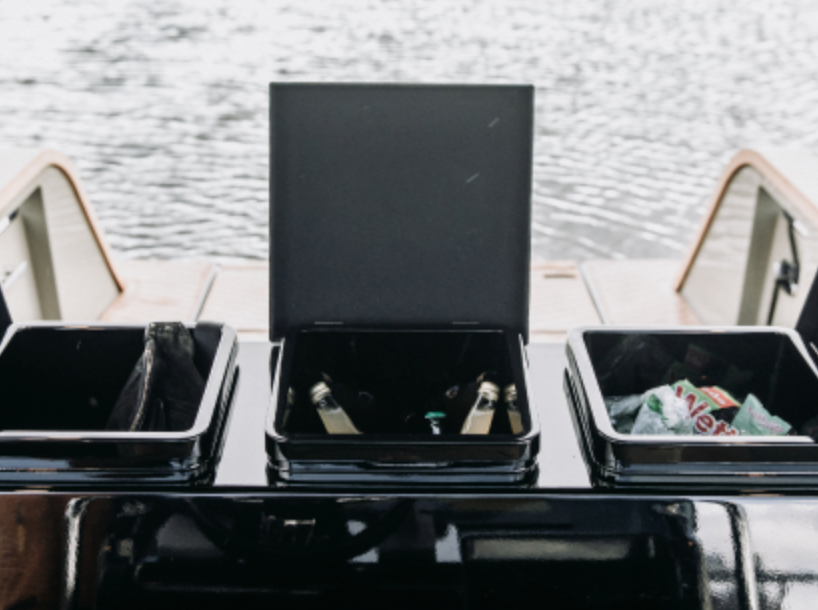
For example, some people will want to use the boat for fishing. Depending and where they want to fish and for what species, they will rig up that 11’ x 7’ (3.32 x 2.13 m) deck differently in each case. For coastal fishing in Florida, anglers might want to mount rocket launchers on the aft end of the deck, or maybe even a fighting chair.
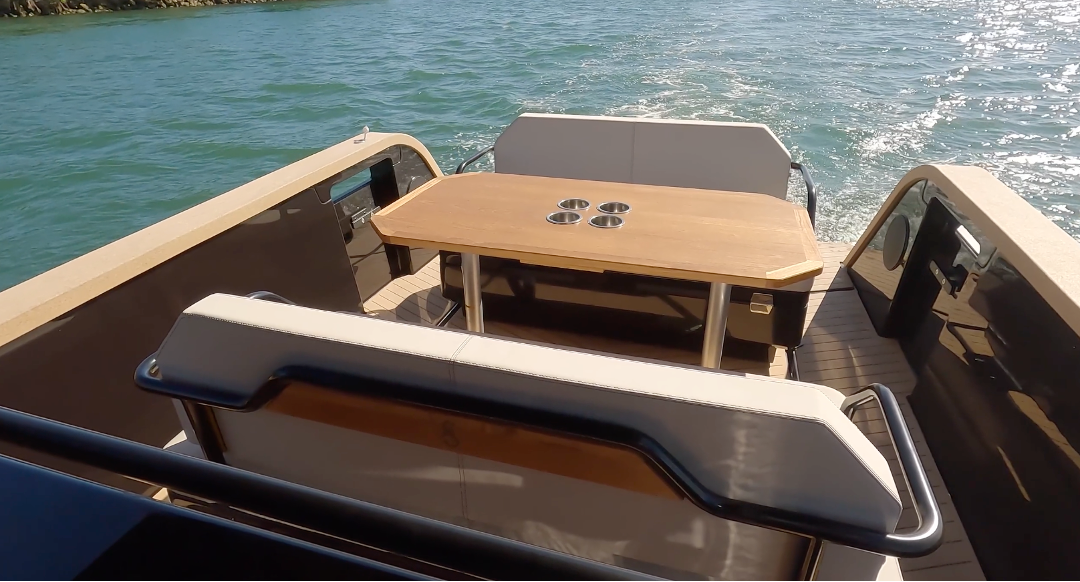

Clearly, the boat is made for scuba diving, and the stern is an ideal launch pad, with plenty of room for tanks, gear stowage and big freshwater containers for washing off gear. Wakeboarders might want to set the two sofas facing aft, sort of like stadium seating, so the show-offs have an audience.
A Perfect Motoryacht Tender
Although we haven’t seen the boat market for this application, we think she is well suited to be a perfect tender for a large motoryacht. Typically, megayacht and superyacht tenders are 25’to 40’ (7.62 – 12.19 m) vessels towed behind the mother ship. They’re used for fishing, shore landings, and for ferrying supplies and guests to and from the mothership. Trouble is that when they are towed in rough conditions, they often swamp and sink. Most insurance carriers will not insure boats used in this way.
The boat’s high bow and ability to slice through waves makes her a good offshore tender, in our opinion, and if green water should come aboard, it will quickly flush out the open stern. Because she is electric, it obviates the need to carry gasoline aboard the mothership, which is inconvenient in a diesel vessel and a fire hazard.
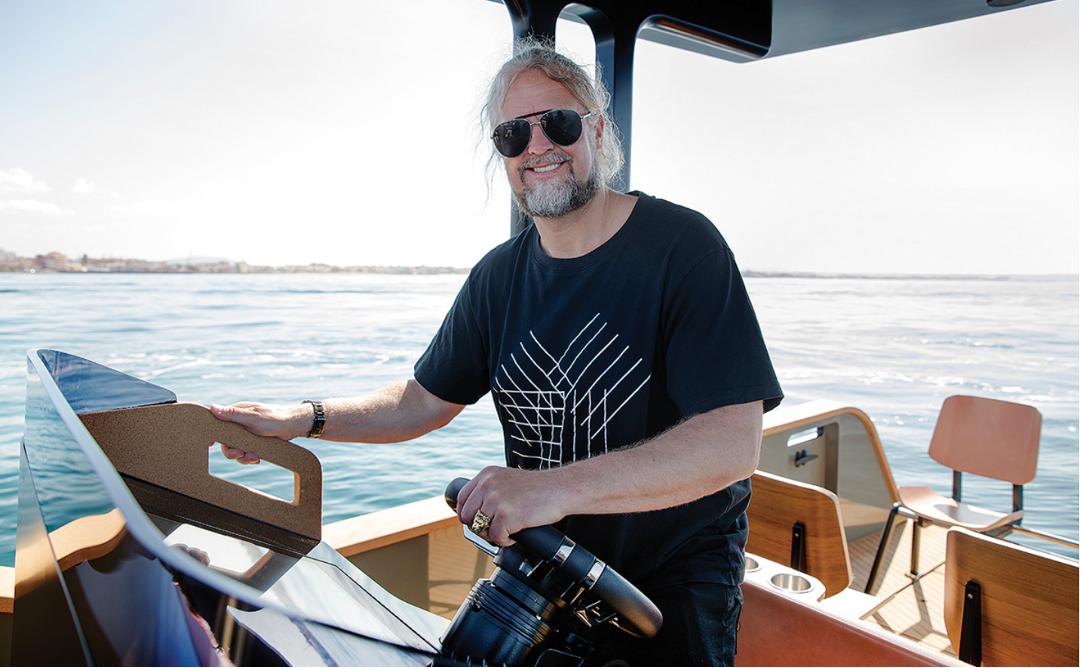
Sustainability and Emissions Reduction Plan
We have never before encountered a boat builder which has documented its ethos so completely and clearly as has X Shore. This, alone, sets this builder apart from all others we have encountered over the years around the world. In a word, not only does the company talk the sustainability talk, it walks the talk. And, it has set up mechanisms to monitor its progress.
Like any business or organization, X Shore’s corporate culture comes from the top, founder Konrad Bergstrom, a charismatic Swede who thinks out of the box. Below are excerpts from its “Sustainability Policy” –
1. Vision for zero negative impact on people and planet.
* We challenge ourselves and work with partners to eliminate negative environmental impact from our operations, as well as the boat’s lifecycle and end-of-life. We aim to ultimately produce boats with net-zero carbon footprint.
*We continuously improve the resource efficiency and circularity of our operations.
2. Continuously grow our positive impact on people and planet.
*We want to inspire and enable more people to enjoy journeys at sea, such that our user base includes all groups represented in the markets where we operate.
* We strive to be an example for others on how to create a culture of true diversity, equality, health and safety.
*We are transparent and active on external arenas to inspire as well as challenge the wider boating industry and beyond.
To read the complete, unabridged, X Shore “Sustainability Policy,” click here…
Observations
Like the Tesla, electric boats and motors are about more than just the boat. It’s about coming to terms with the future of the planet and taking care of it so our children and grandchildren can continue to enjoy it as we have. X Shore is making a bold statement that all can see.
We think the X Shore Eelex 8000 is remarkably innovative and ahead of its time. Konrad Bergstrom is a visionary, but it will take other visionaries who have the self-confidence and courage to take aboard Konrad’s world-view and promulgate it among the thought-leaders of boating.
Already in the U.S. are two people who have already been influenced by Bergstrom and his sustainable concept --
Roger Moore -- around the world sailor, serial entrepreneur himself, owner/operator of an 80’ trawler yacht he lives aboard, founder of Nautical Ventures in South Florida which the fastest growing boat dealership in the country -- has become a stocking dealer, putting his time and treasure behind the X Shore concept.
Rives Potts -- five-time America’s Cup crew, winning offshore ocean racing boat skipper, with 3 transatlantic, 20 Bermuda races, 18 SORCs, 3 Sydney-Hobart and dozens of other races to his credit, former Commodore of the New York Yacht Club, and current President and COO of Safe Harbor Marinas – has recently bought eight X Shore vessels for as many of his marinas.
These two men certainly know the sea, know boating and know the boating market. The only question is…who’s next?